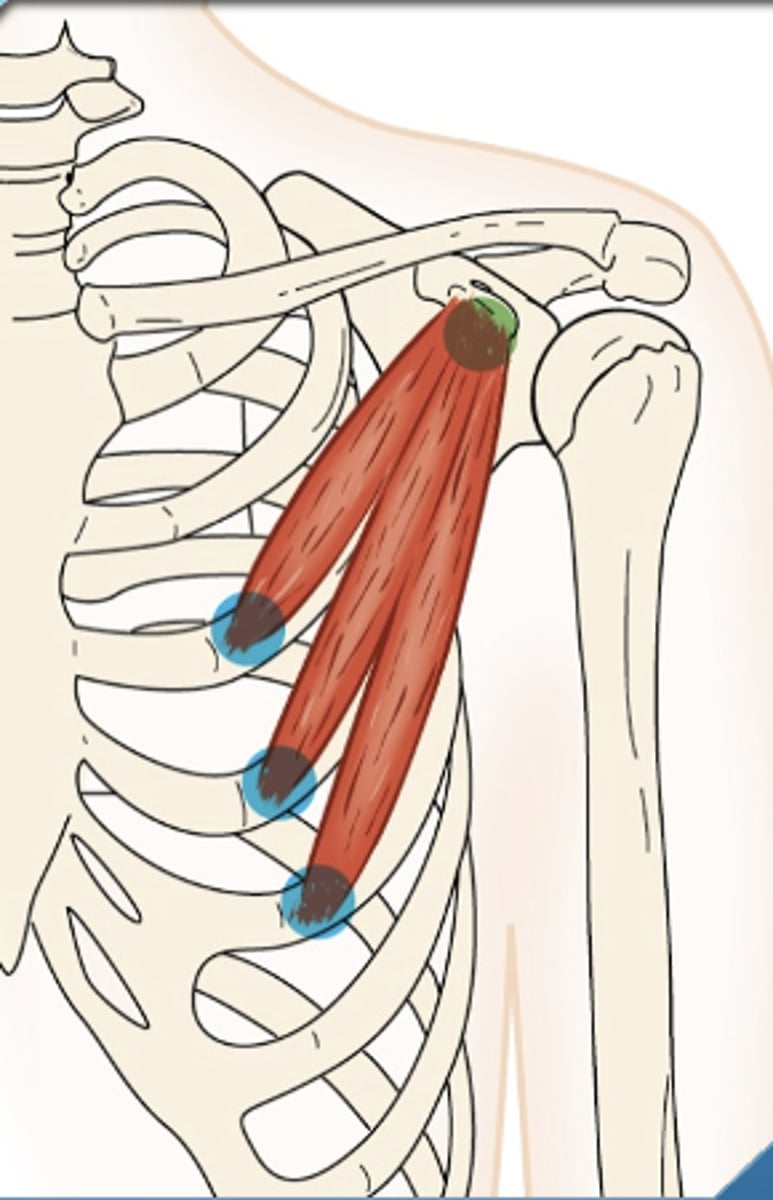KINE 476 Exam 4
1/237
There's no tags or description
Looks like no tags are added yet.
Name | Mastery | Learn | Test | Matching | Spaced |
|---|
No study sessions yet.
238 Terms
Shoulder girdle contains
sternum, clavicle, scapula, sternoclavicular joint, acromioclavicular joint, and scapulothoracic joint
Shoulder (glenohumeral) joint
glenoid fossa of the scapula and head of humerus
The motions of the shoulder girdle and shoulder joint are:
motions at each are interrelated
Shoulder girdle articulates with
- head of humerus (shoulder joint)
- manubrium of sternum
- sternoclavicular [SC] joint
- each other acromioclavicular [AC] joint
The shoulder girdle
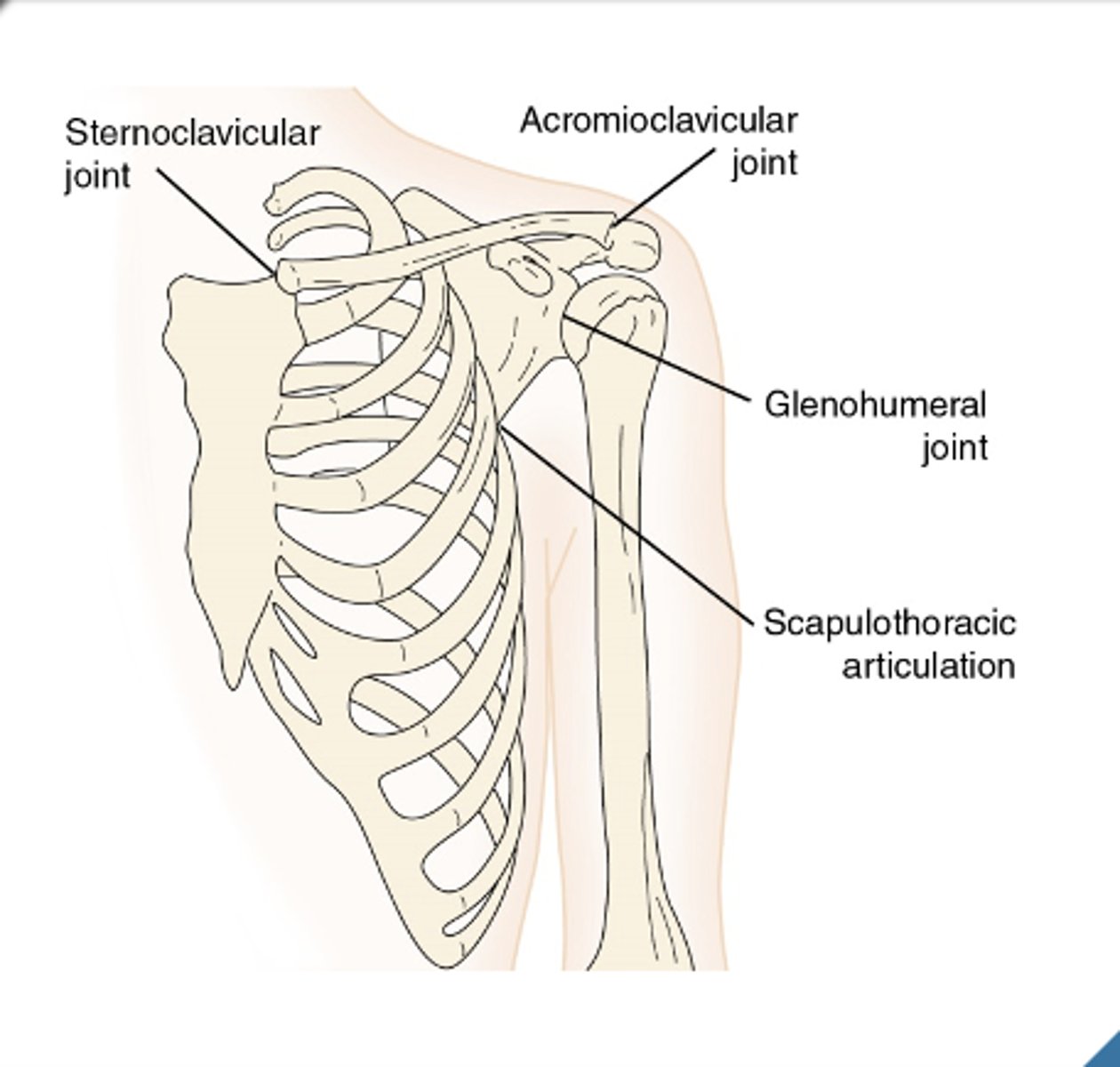
Elevation
- scapula move superiorly
- linear movement
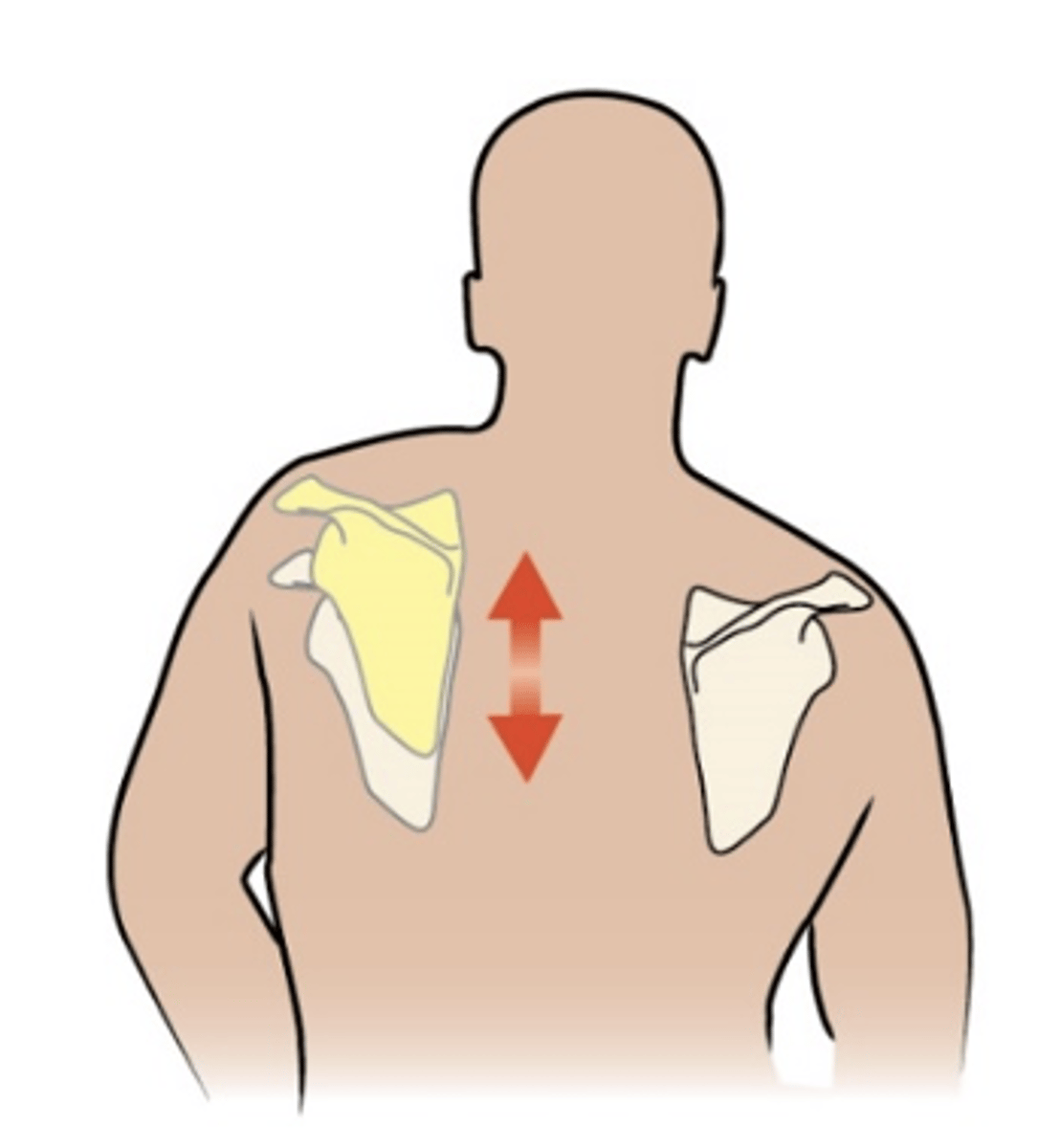
Depression
- scapula moves inferiorly
- linear movement
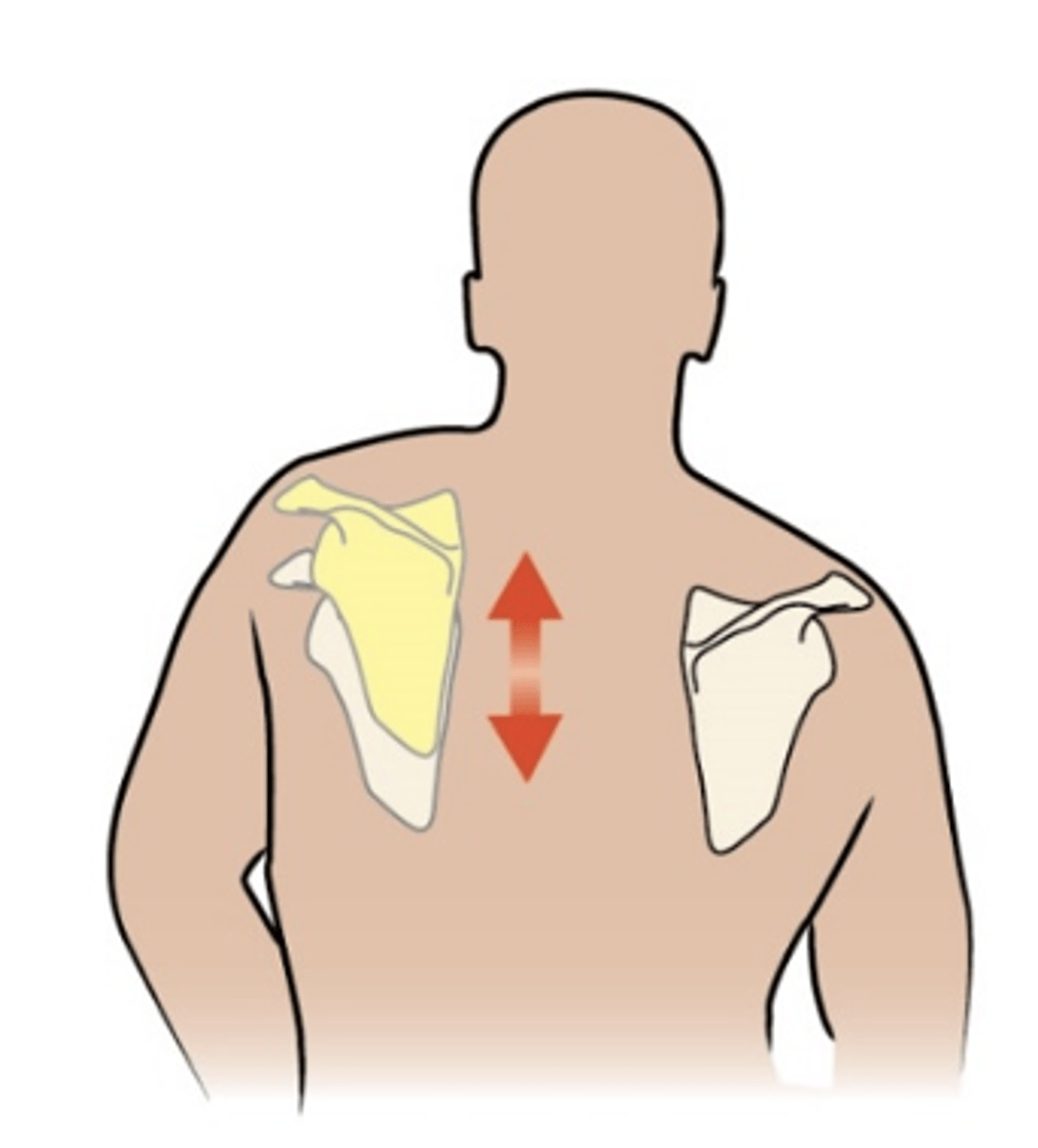
Protraction
scapula moves away from the vertebral column
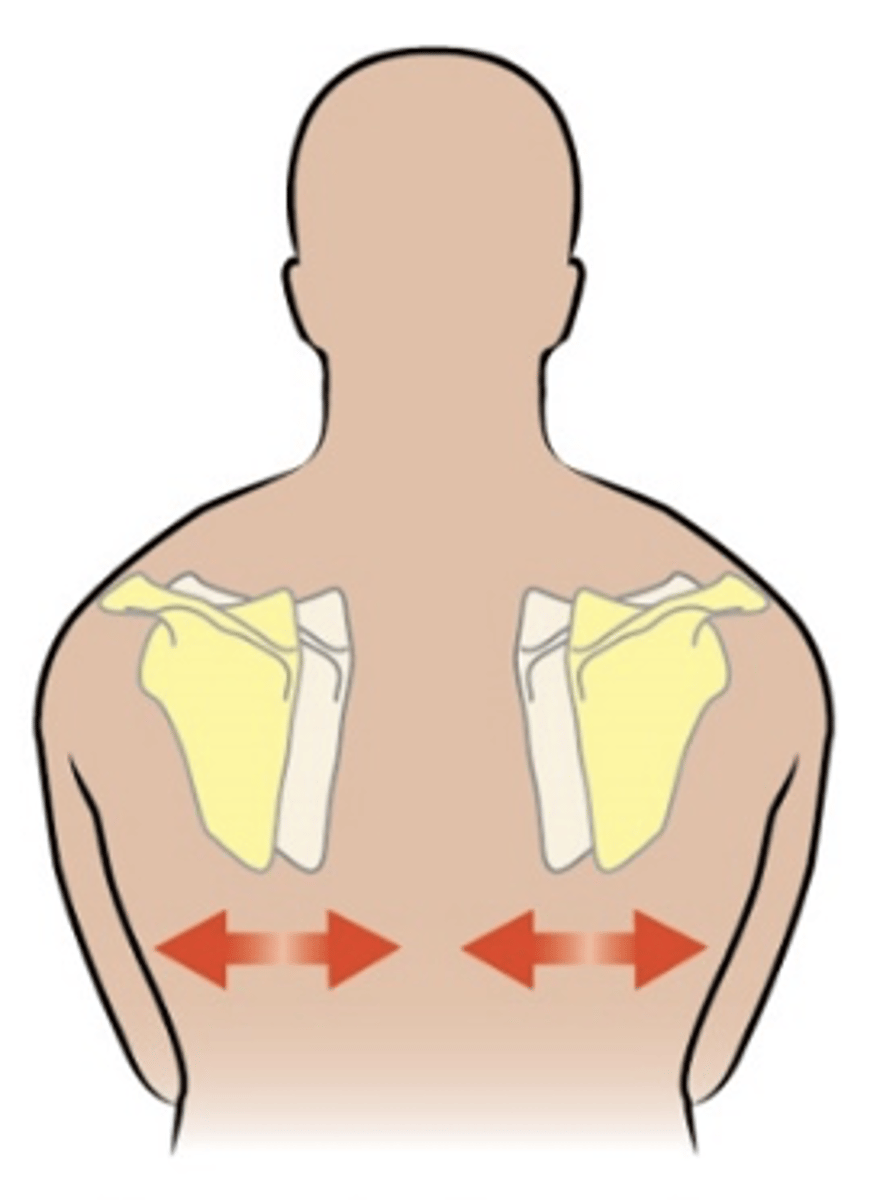
Retraction
scapula moves toward the vertebral column
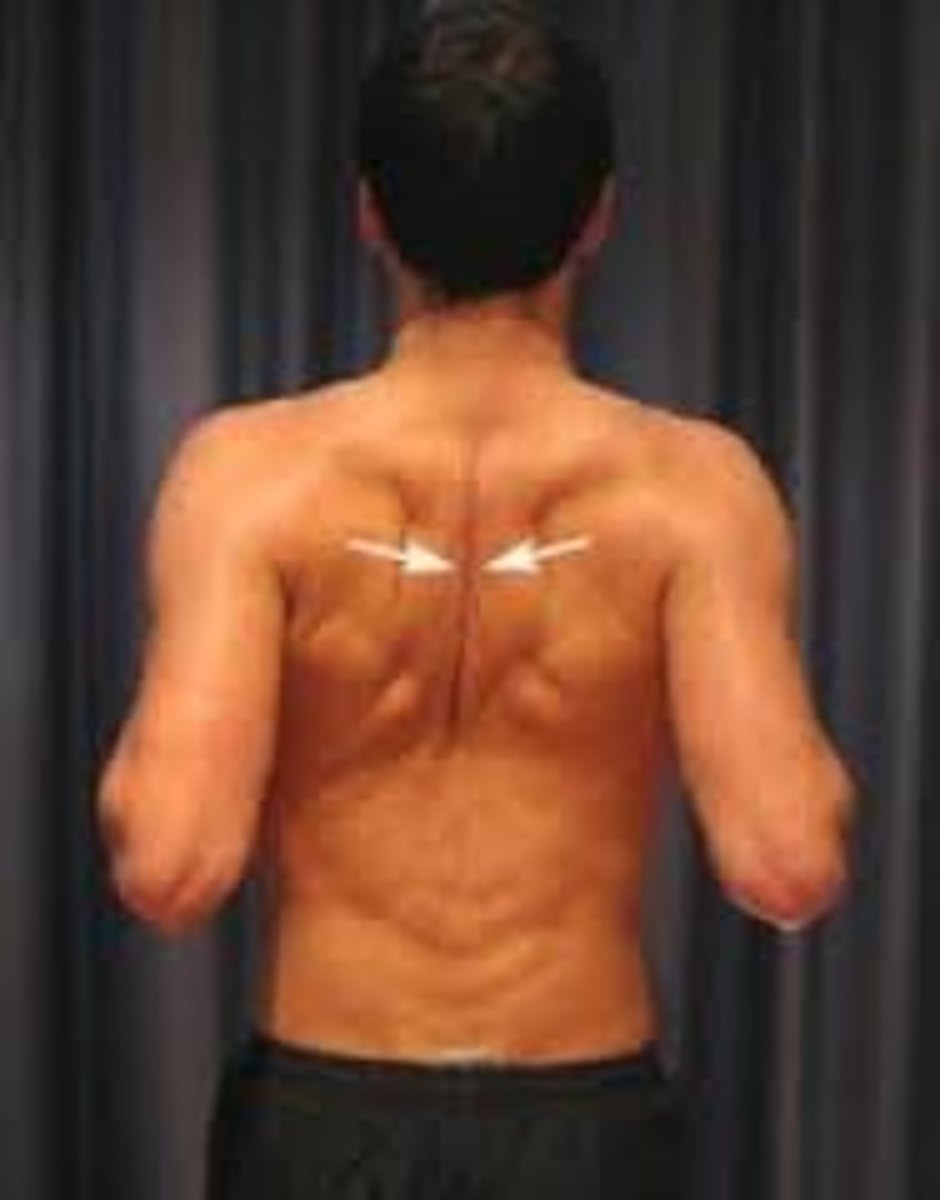
Upward rotation
rotation of the inferior angle laterally and superiorly
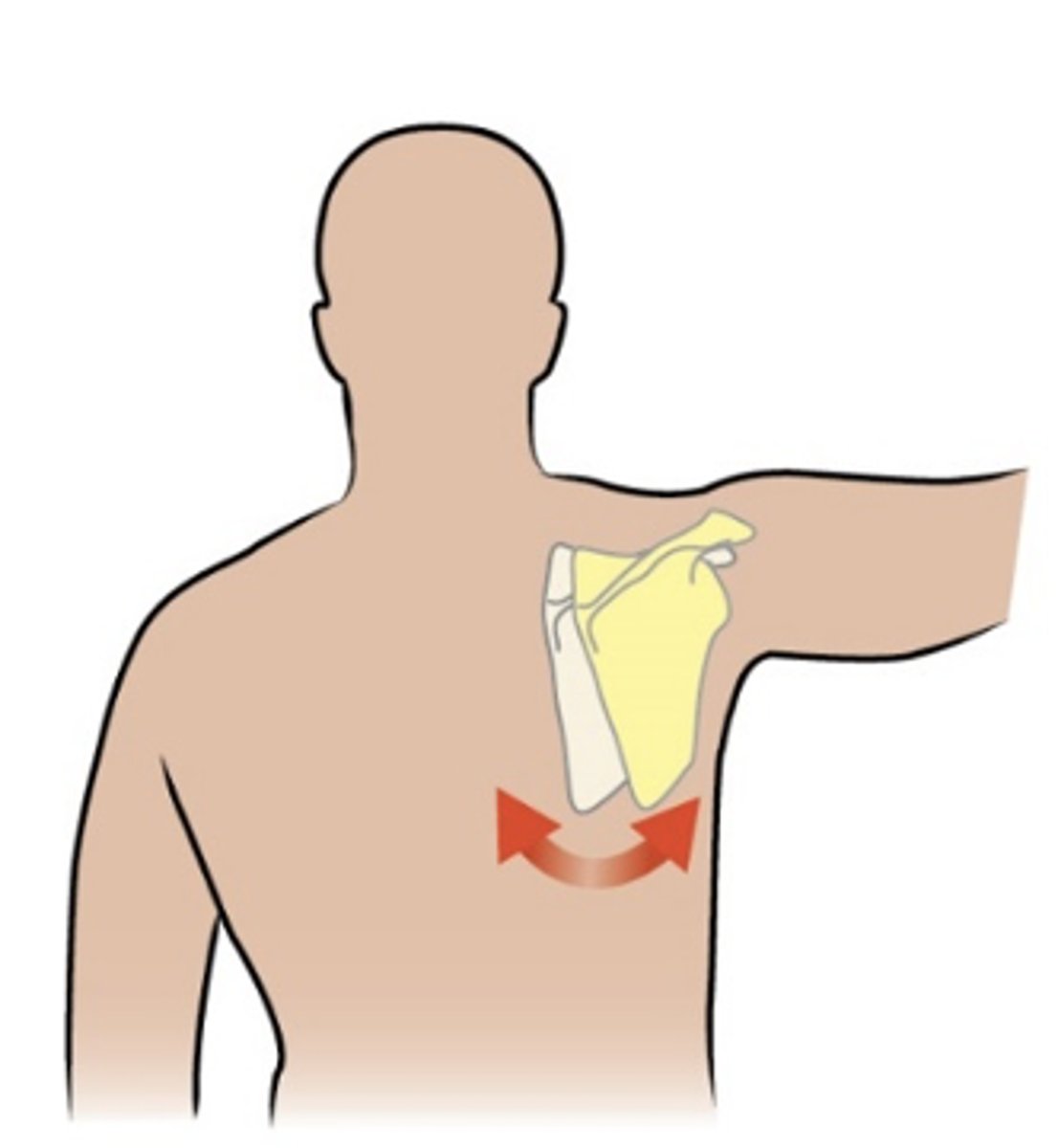
Downward rotation
rotation of the inferior angle medially and inferiorly
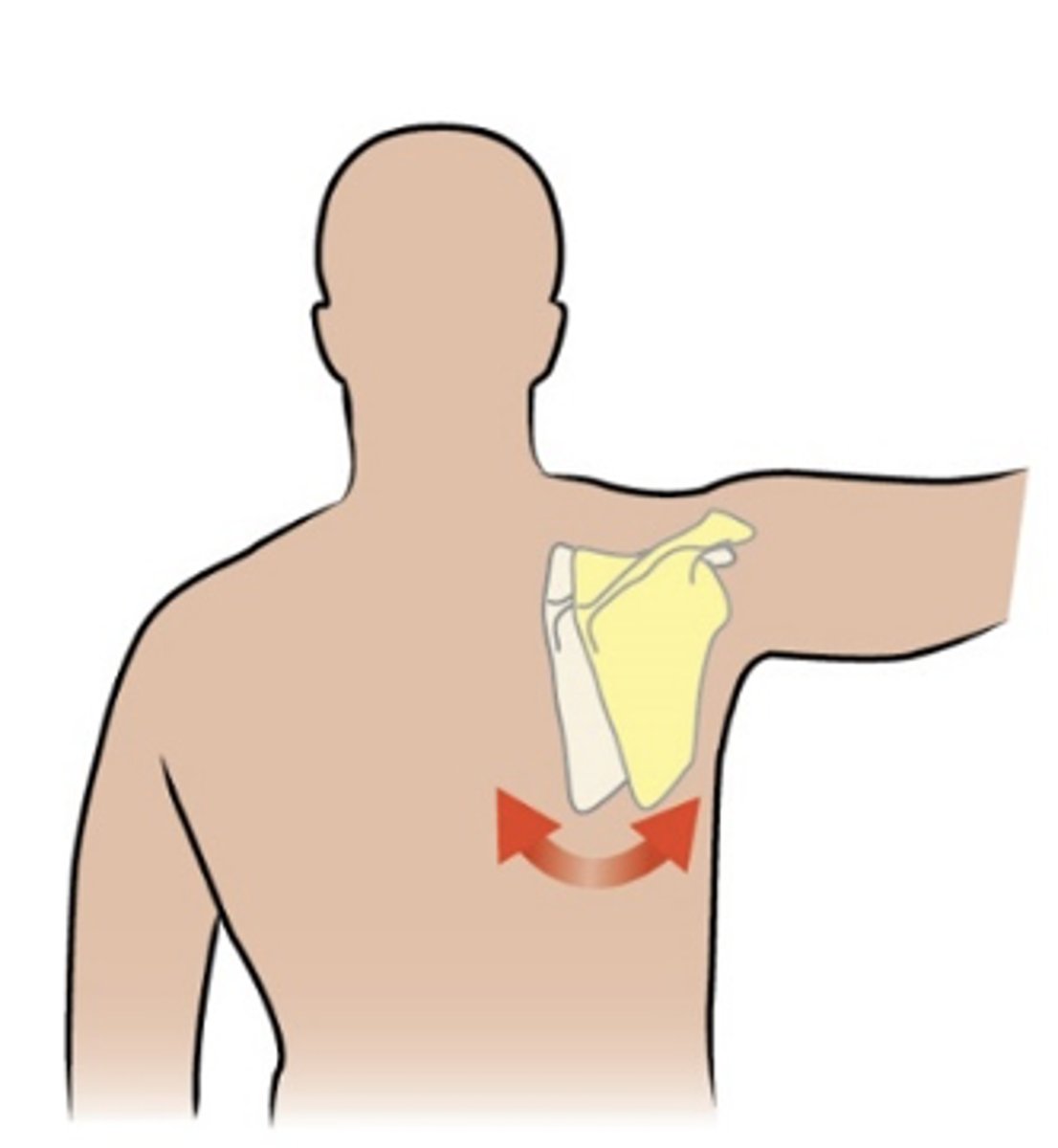
Scapular tilt
rotation of the inferior angle posteriorly
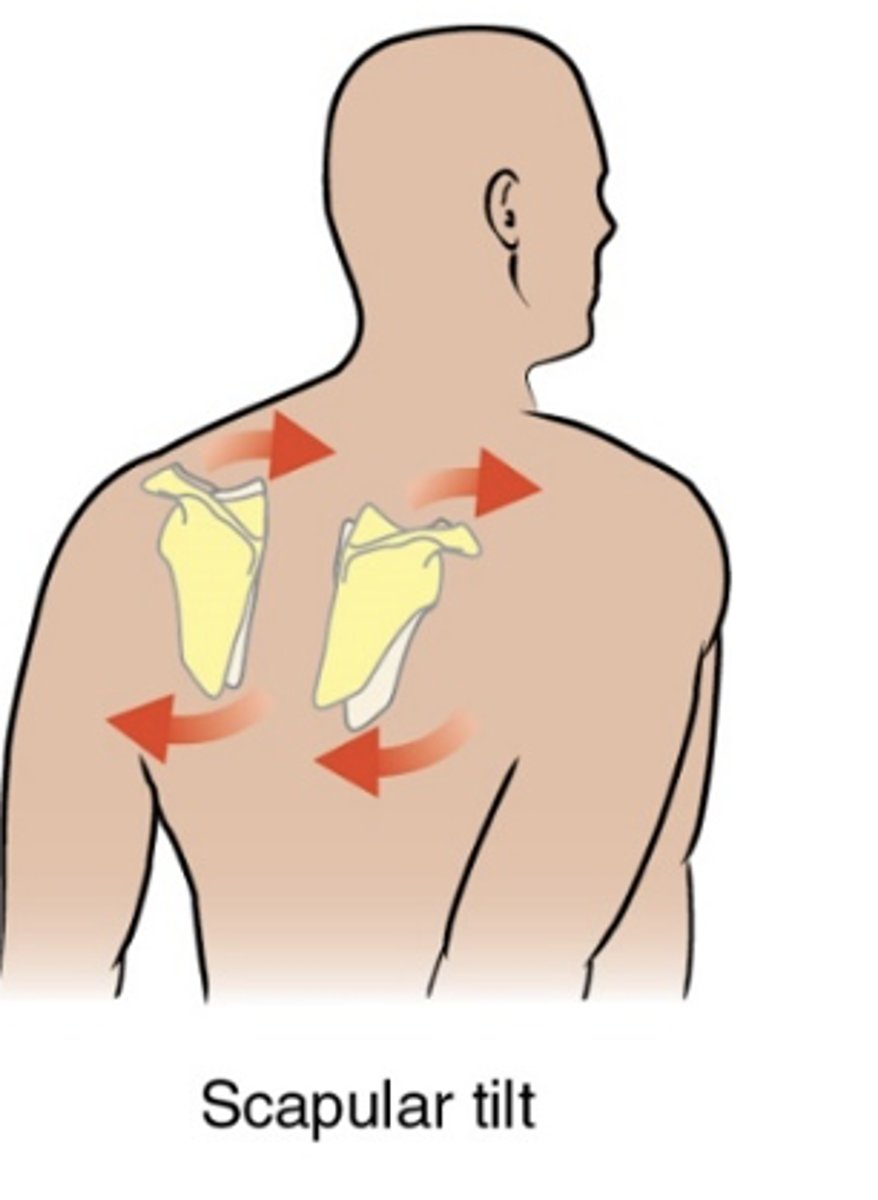
Scapular winging
movement of the medial border posteriorly
Resting position of the scapula on the thorax
- located between the 2nd and 7th ribs
- vertebral boarder approximately 2-3 inches lateral of the spinous processes
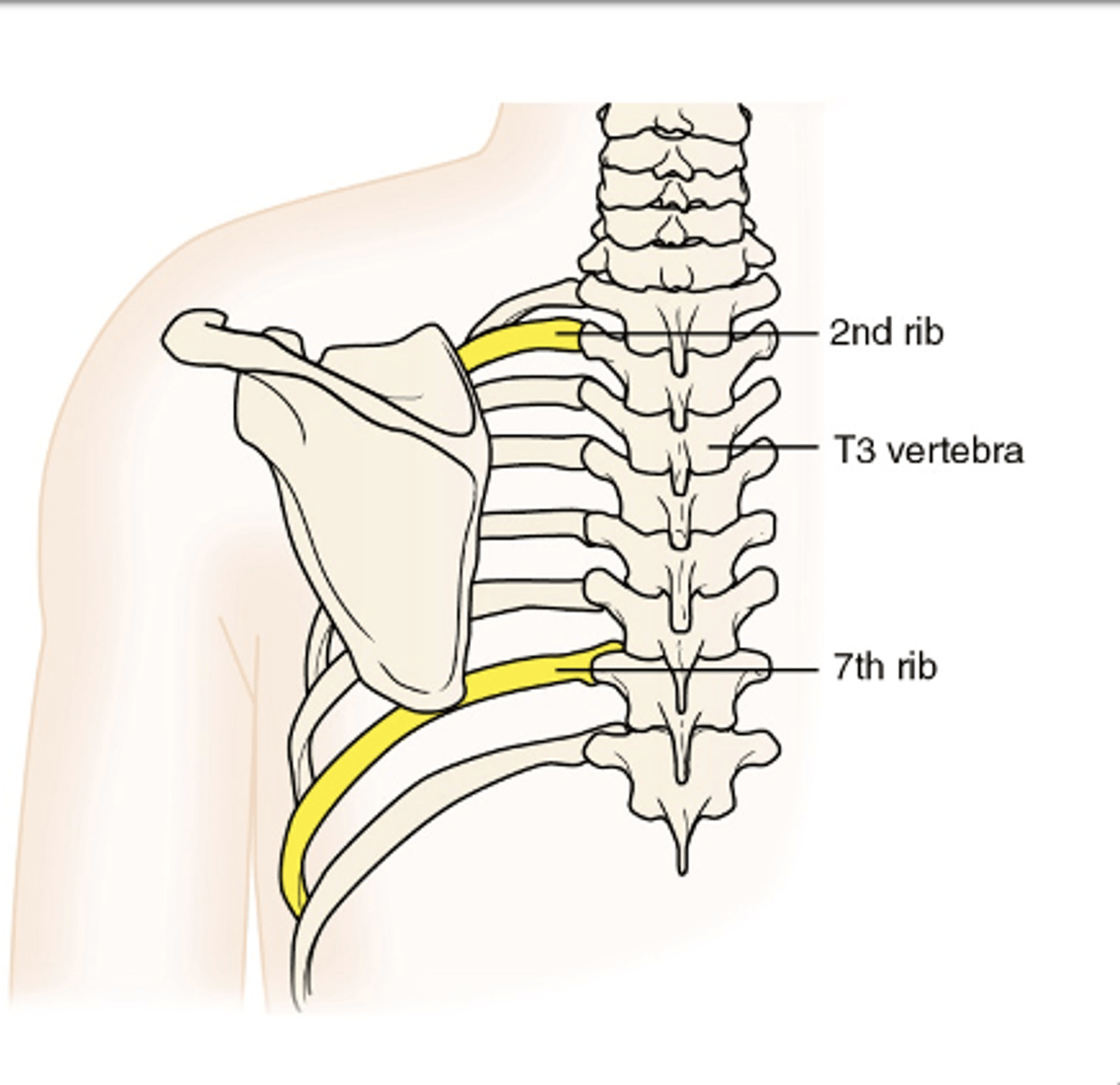
Plane of the scapula
is approximately 30 degrees forward of the frontal plane
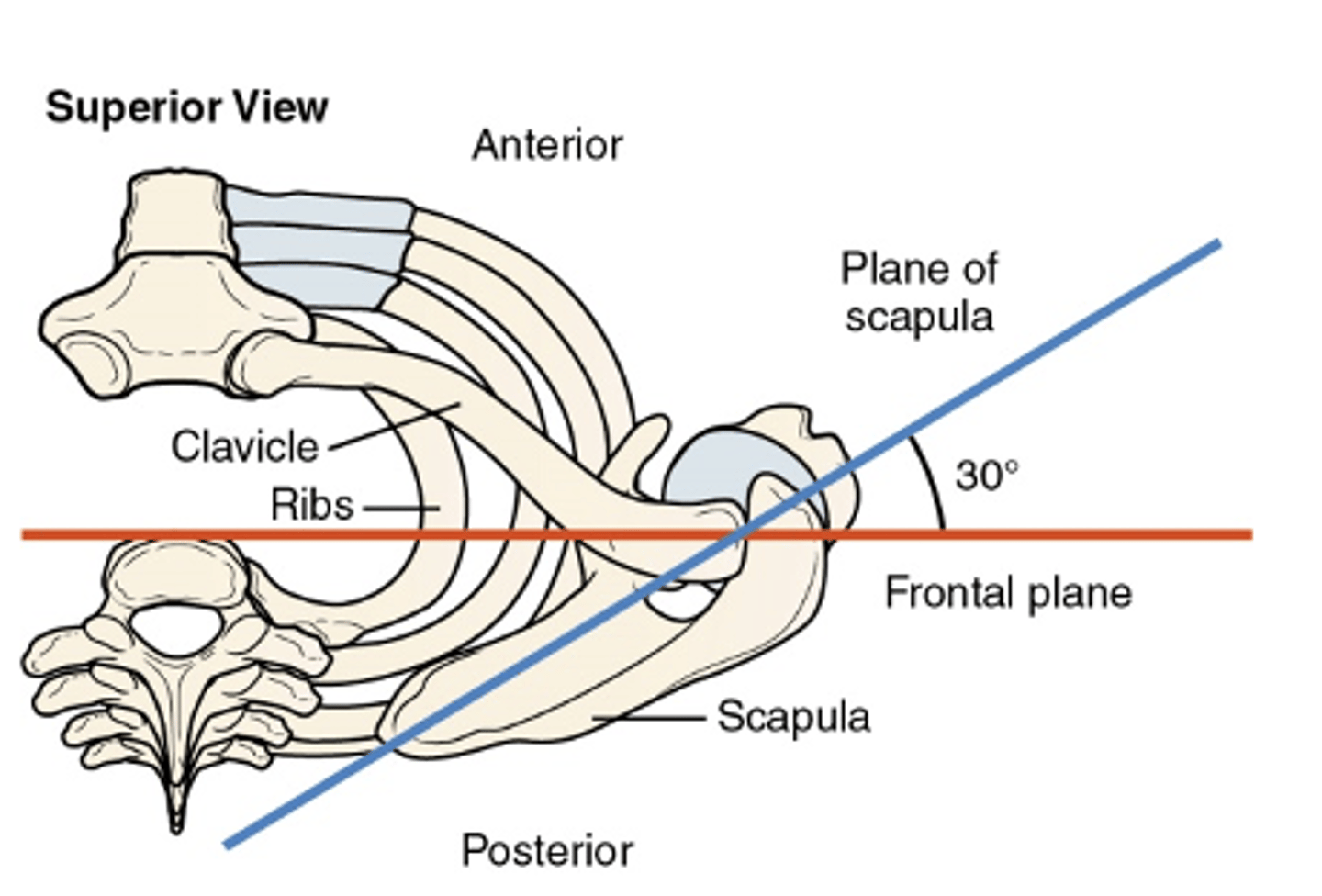
Scaption
movements of the shoulder joint that occur in the scapular plane rather than a sagittal or frontal plane
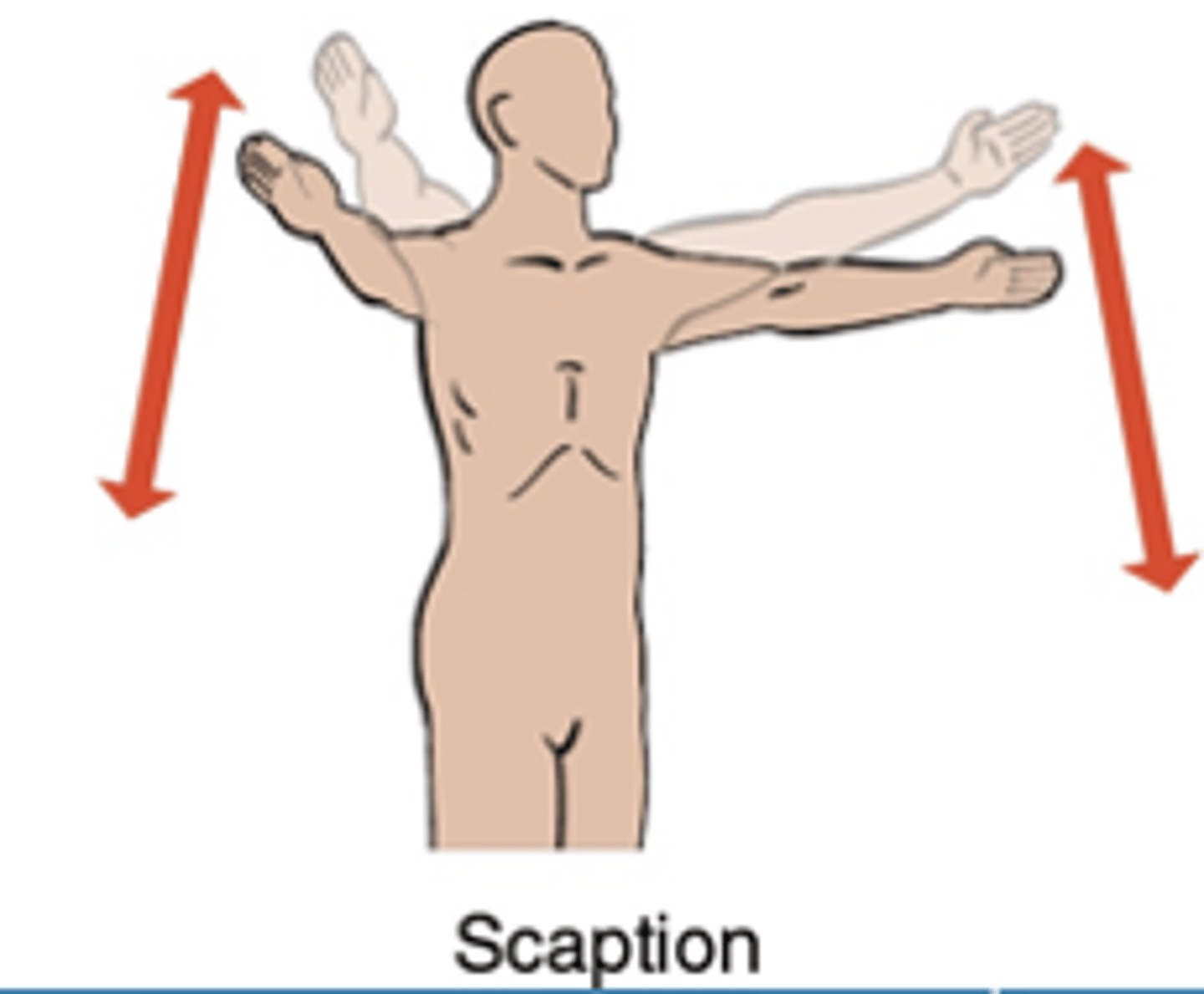
Relationship of shoulder girdle and glenohumeral joint movement is called
scapulohumeral rhythm
Scapulohumeral rhythm
The coordinated rotational movement of the scapula that accompanies abduction and adduction of the humerus.
Scapulohumeral rhythm ratio
2:1 ratio
What does the scapulohumeral rhythm assist in:
maintaining a functional length-tension in abductor muscles
Relationship of shoulder girdle and glenohumeral joint movement
- full ROM of shoulder joint motions requires motion of the shoulder girdle
- first 30 degrees of shoulder abduction occurs only at the glenohumeral joint without scapular motion
- after that, two (2) degrees of shoulder abduction must be accompanied by (1) degree of scapular upward rotation
Advantages of Scapulohumeral Rhythm
- scapular upward rotation avoids contact of greater tubercle of humerus with acromion process.
- smaller arthrokinematic motions within the glenohumeral joint are required as the humeral head rotates within the shallow glenoid fossa.
Landmarks of the scapula
- superior angle
- inferior angle
- vertebral border
- axillary border
- spine
- acromion process
- glenoid fossa
- coracoid process
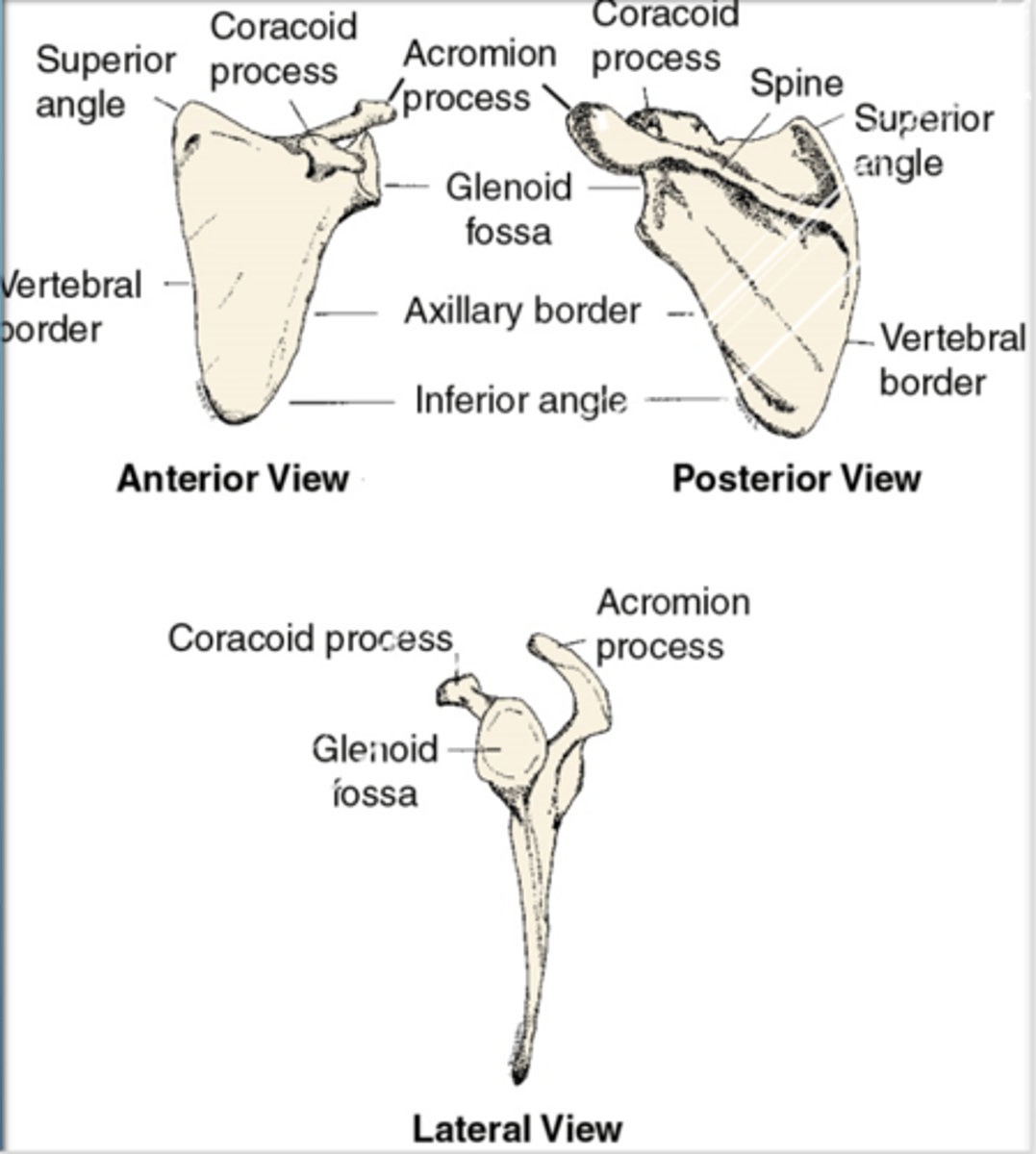
Superior angle of scapula
- superior medial aspect
- attachment for levator scapula
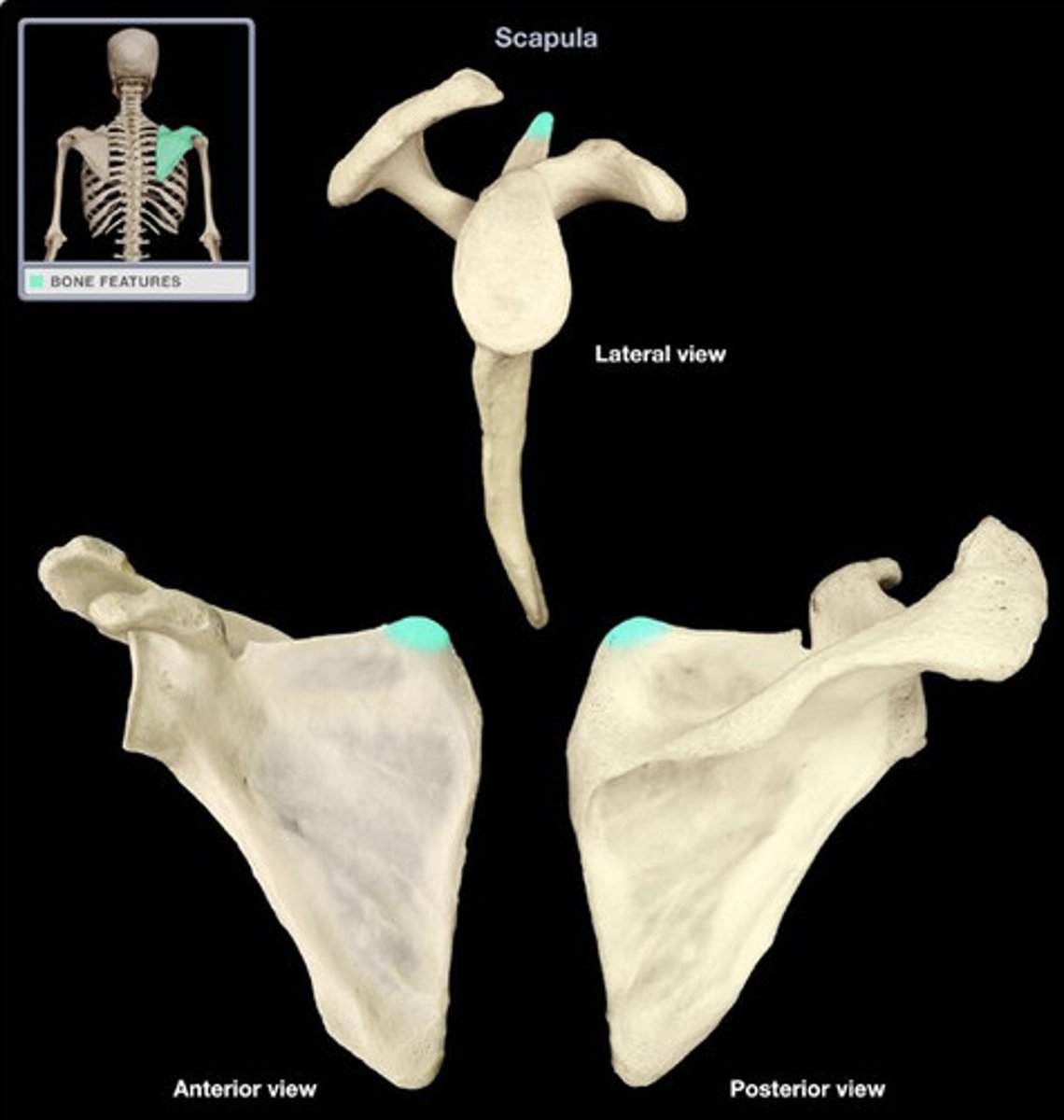
Inferior angle of scapula
- most inferior point
- where vertebral and axillary borders meet
- point of reference for determining scapular rotation
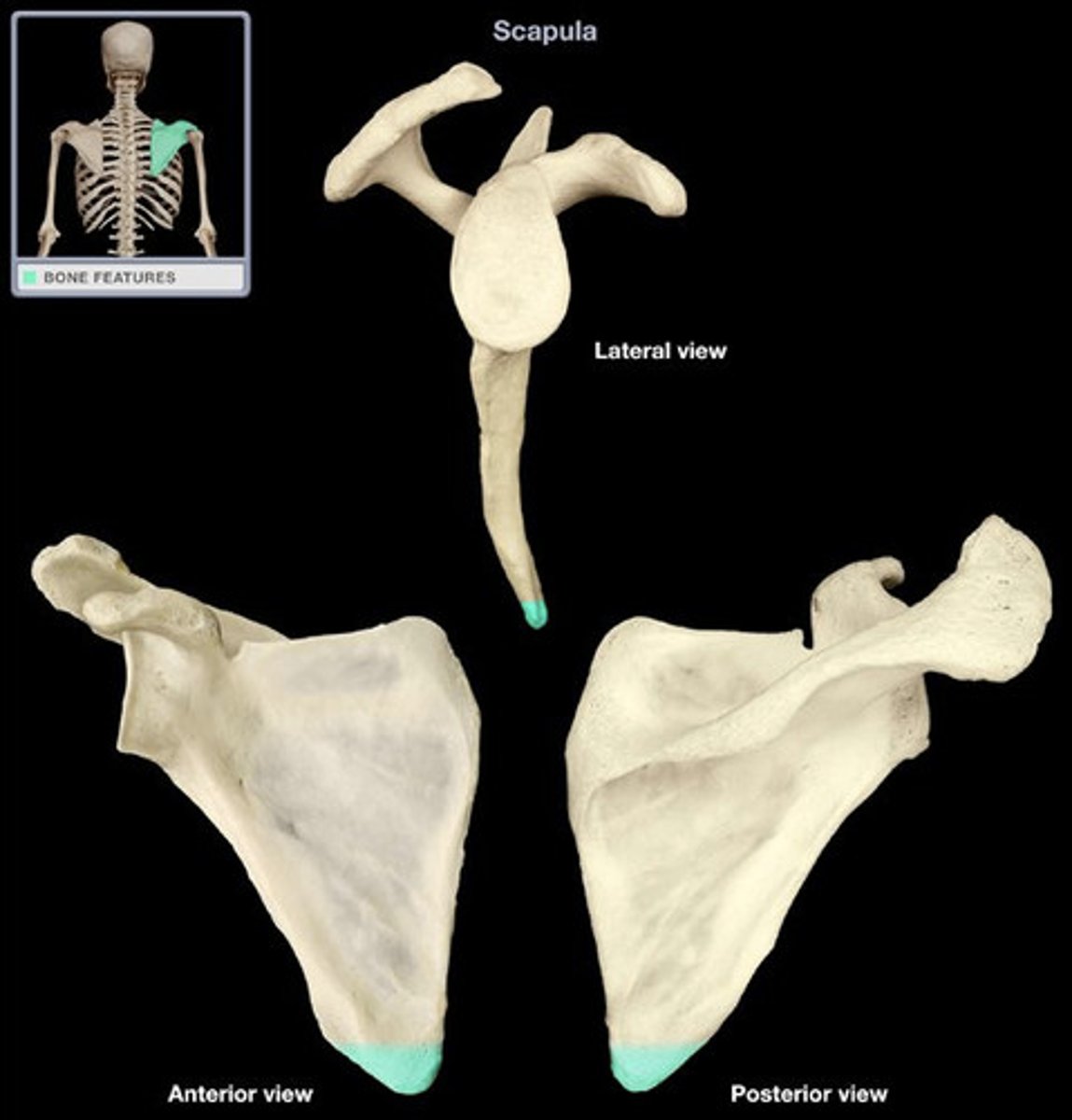
Vertebral border of the scapula
- medial border between superior and inferior angles
- attachment for rhomboid, levator scapula, and seratus anterior muscles
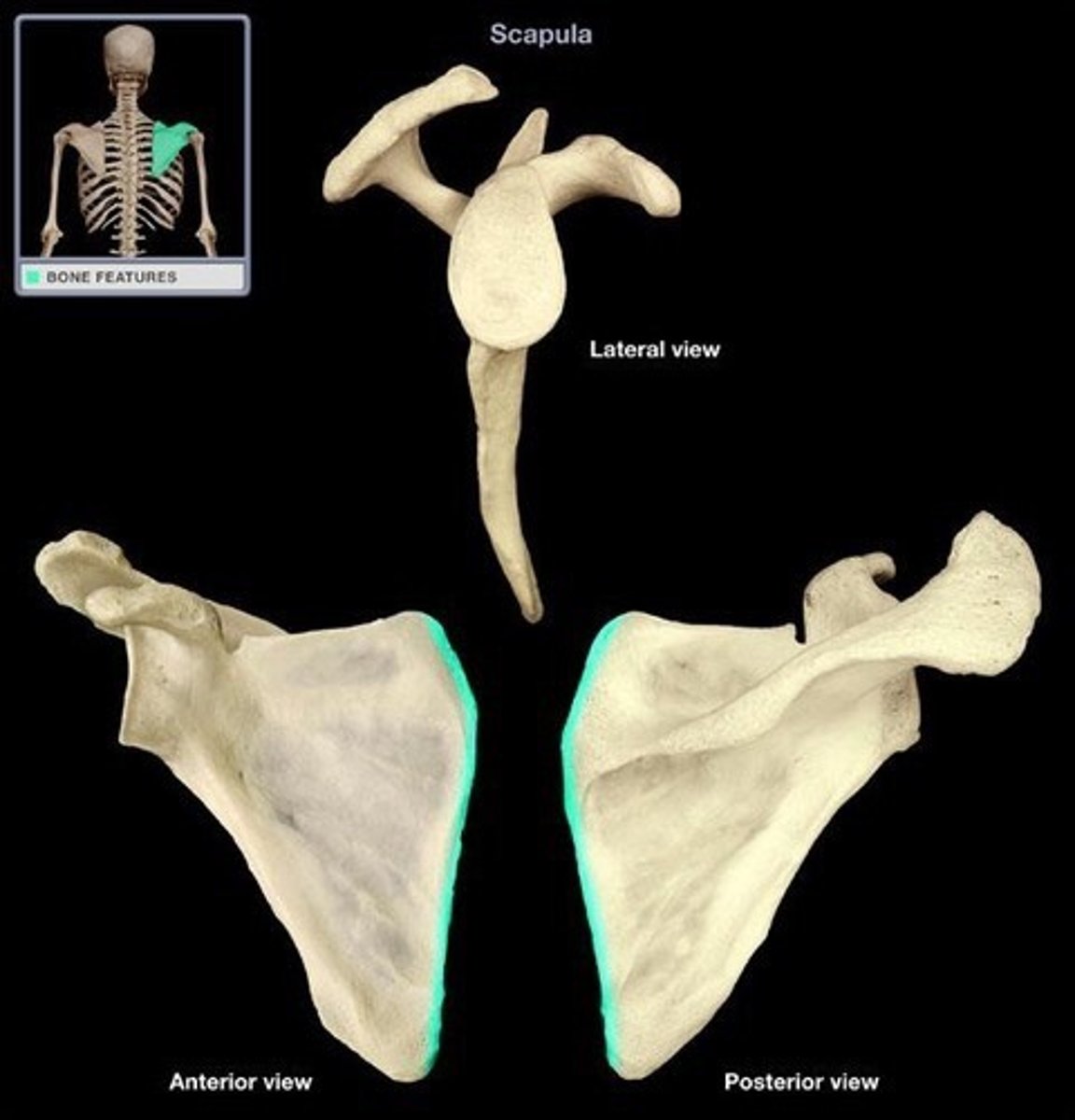
Axillary border of scapula
- lateral border between glenoid fossa and inferior angle
- attachment for teres major, teres minor, and triceps brachii muscles
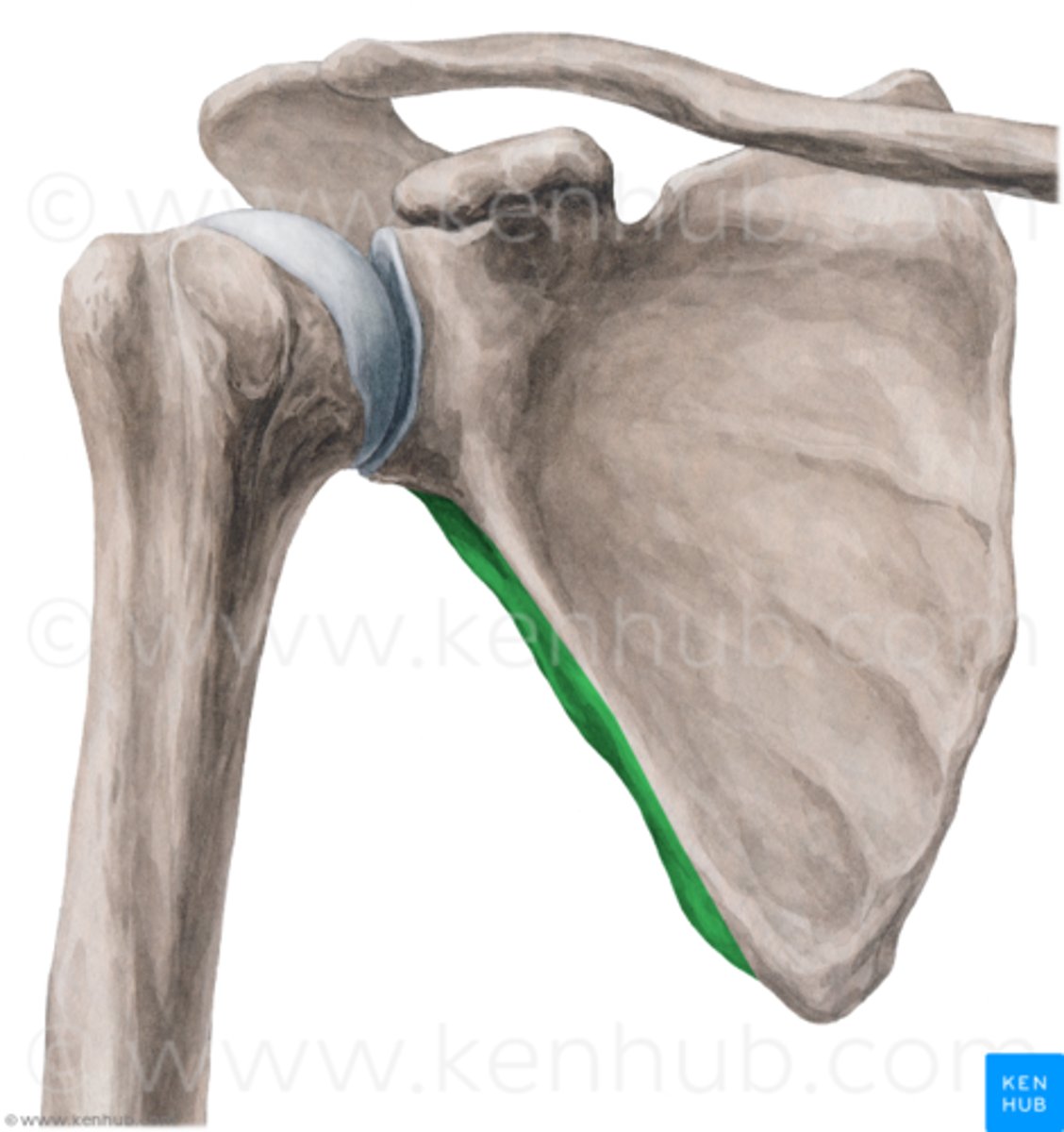
Spine of scapula
- projection on posterior surface from verterbal border to acromion process
- attachment for middle and lower trapezius and posterior deltoid muscle
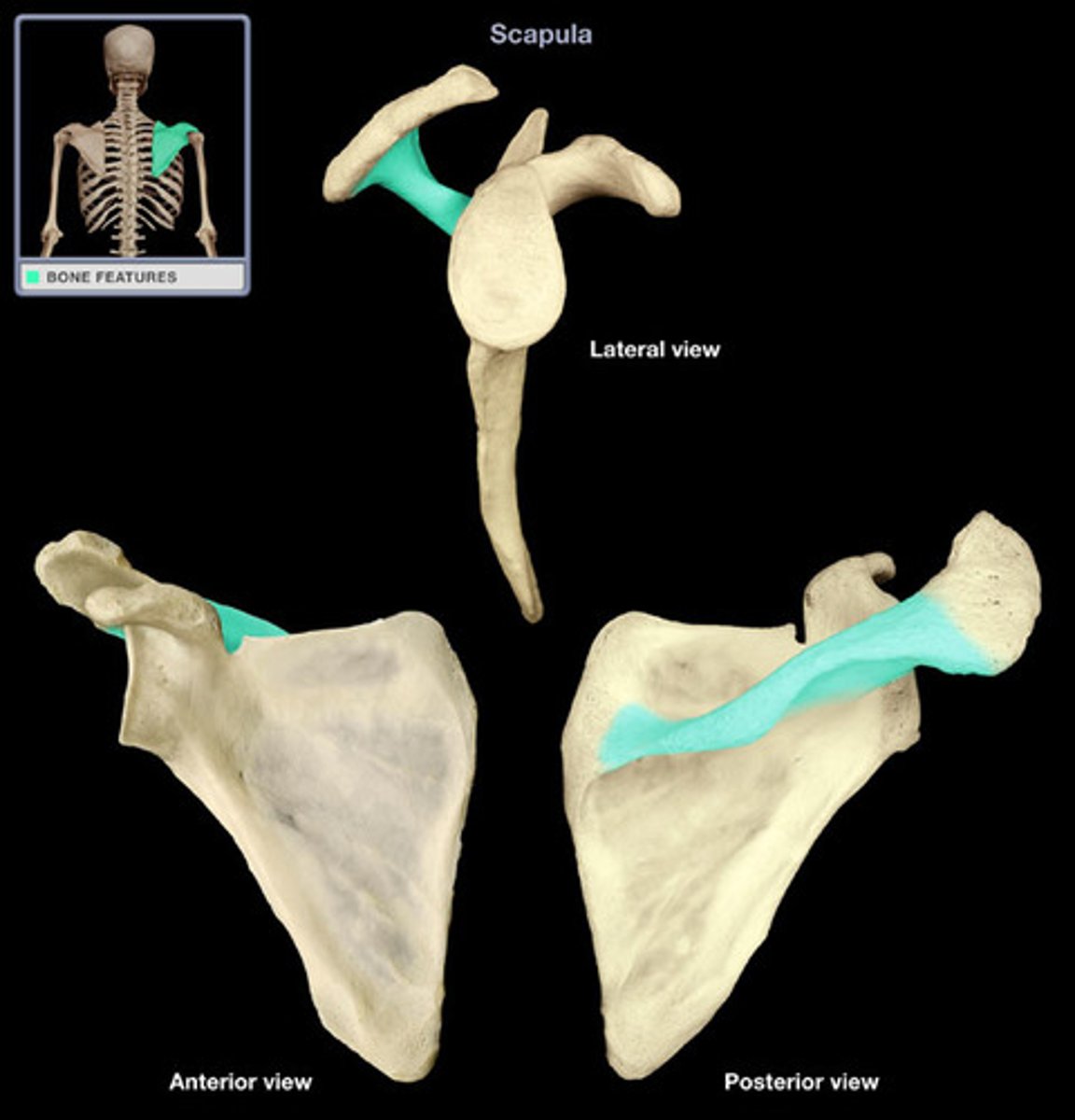
Coracoid process of the scapula
- hook-shaped projection on anterior-superior surface
- attachment for pectoralis minor, coracobrachialis, and short head of the bicep brachii muscles
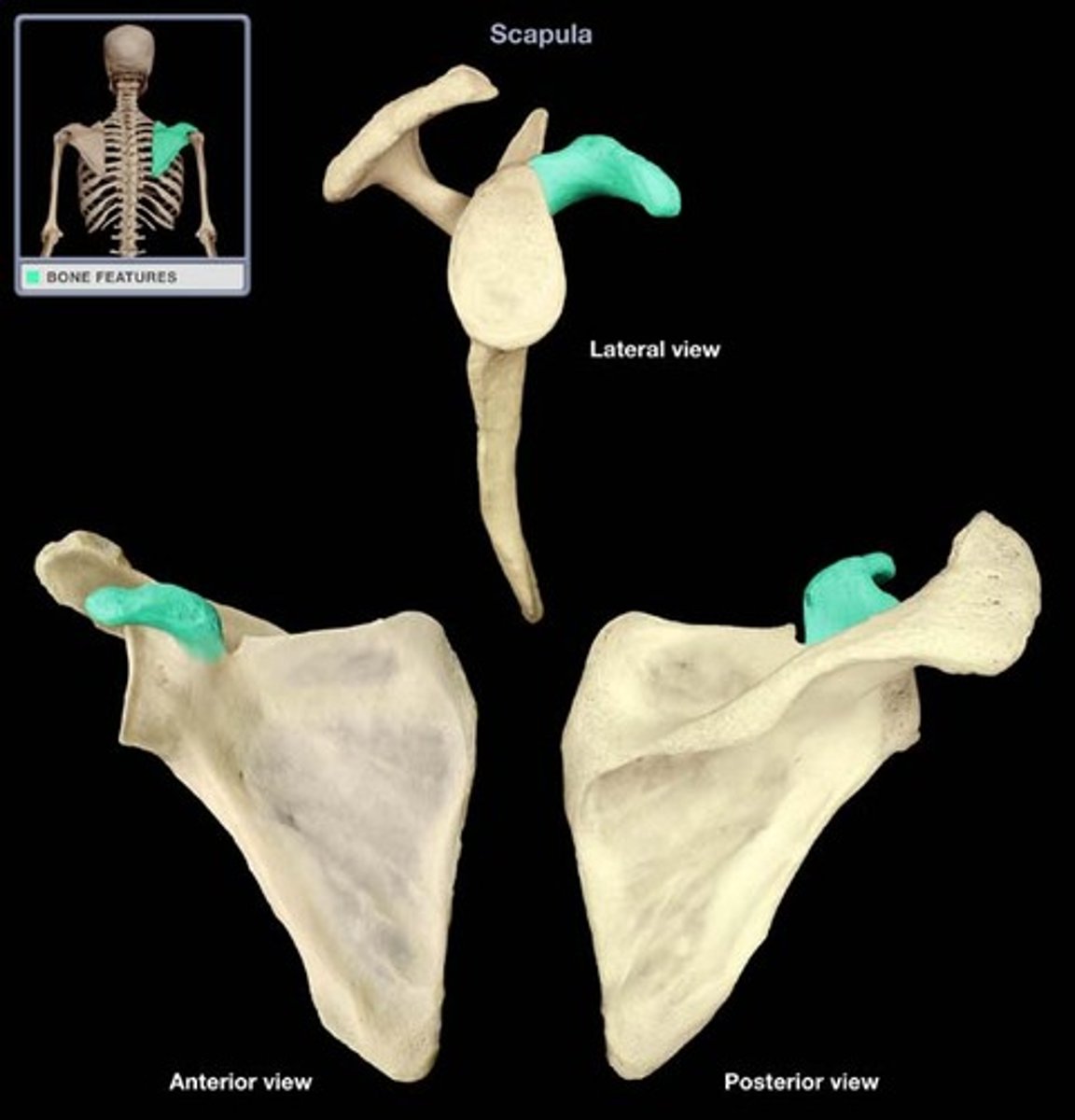
Acromion process of scapula
- lateral broad, flat end of spine of scapula
- attachment for upper trapezius and middle deltoid muscles
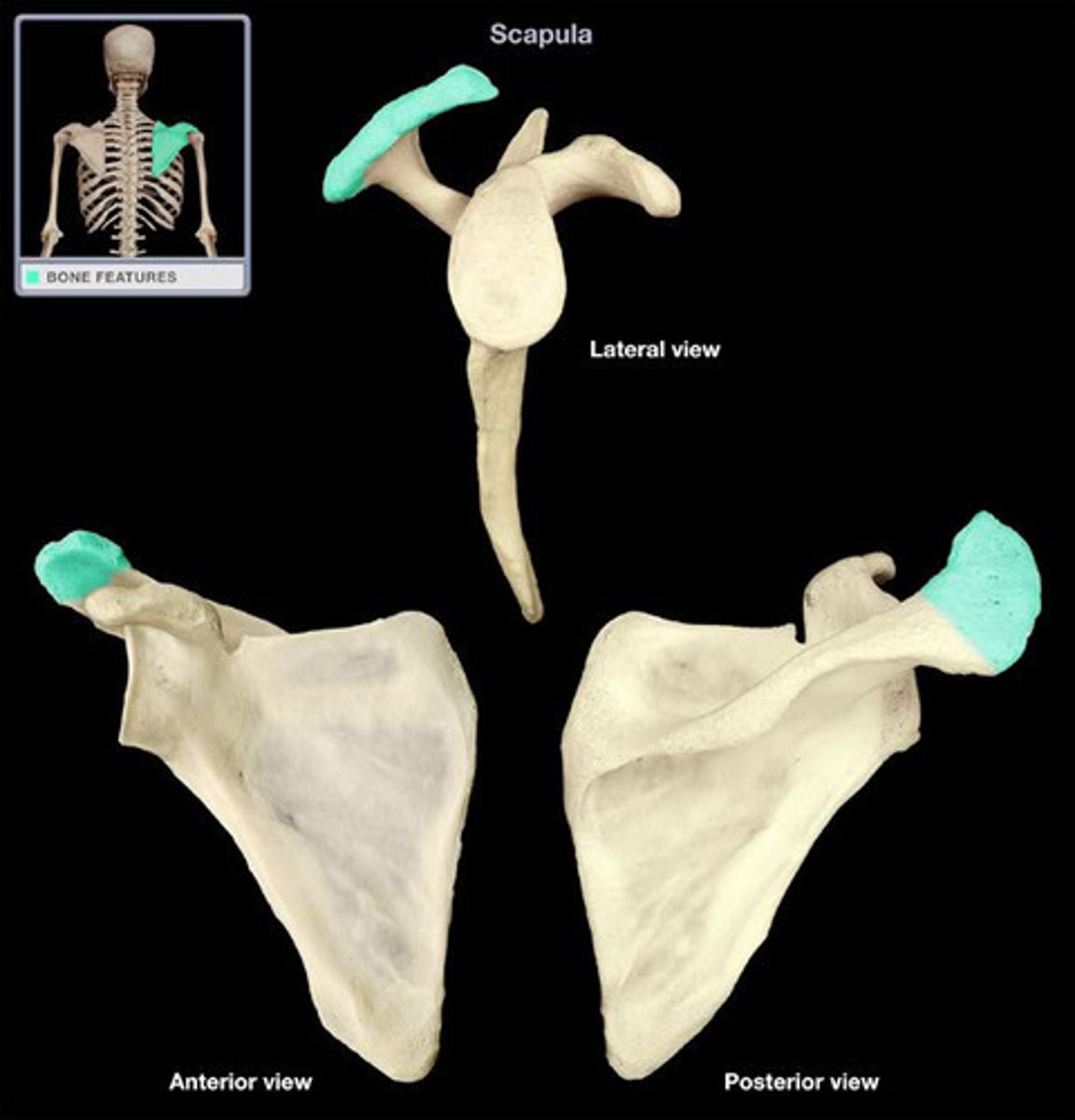
Glenoid fossa of the scapula
- slightly concave surface at superior end of axillary border
- faces slightly anteriorly, laterally, and superiorly
- third angle of triangular shape of the scapula
- articulates with humerus.
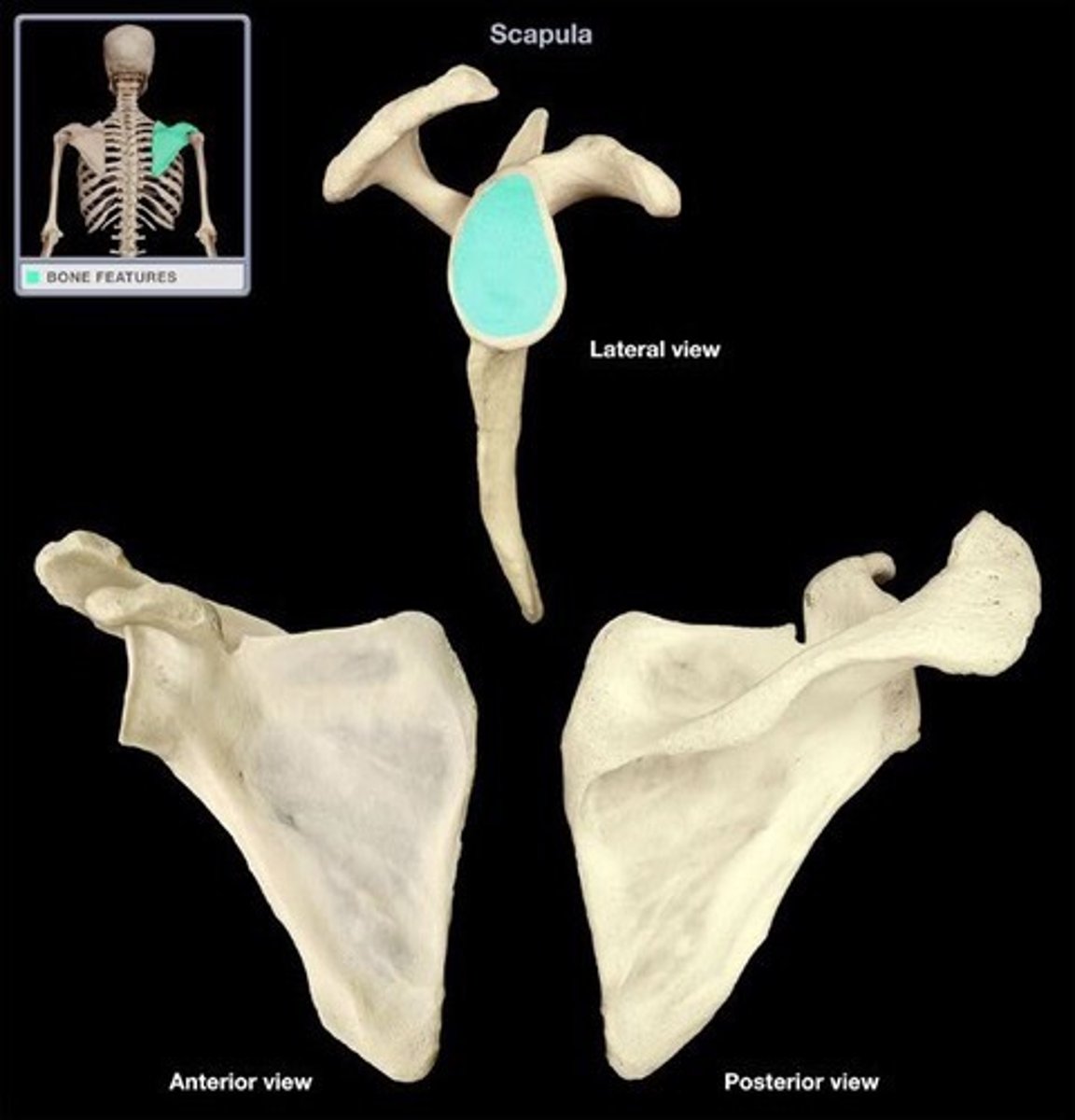
Landmarks of the clavicle
sternal end, acromial end, body
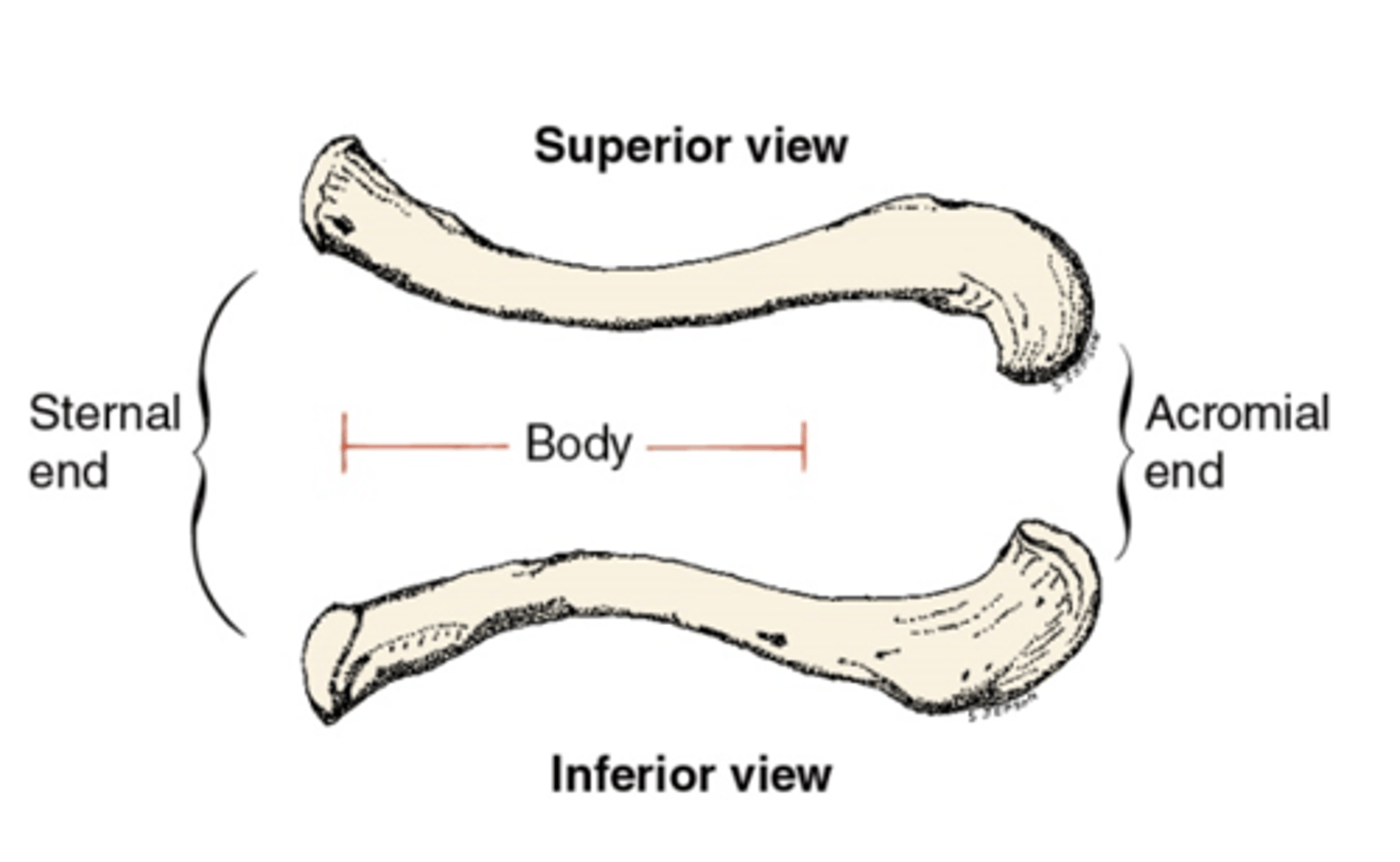
Clavical
s-shaped bone connecting the upper extremity appendicular skeleton to the axial skeleton at the SC joint
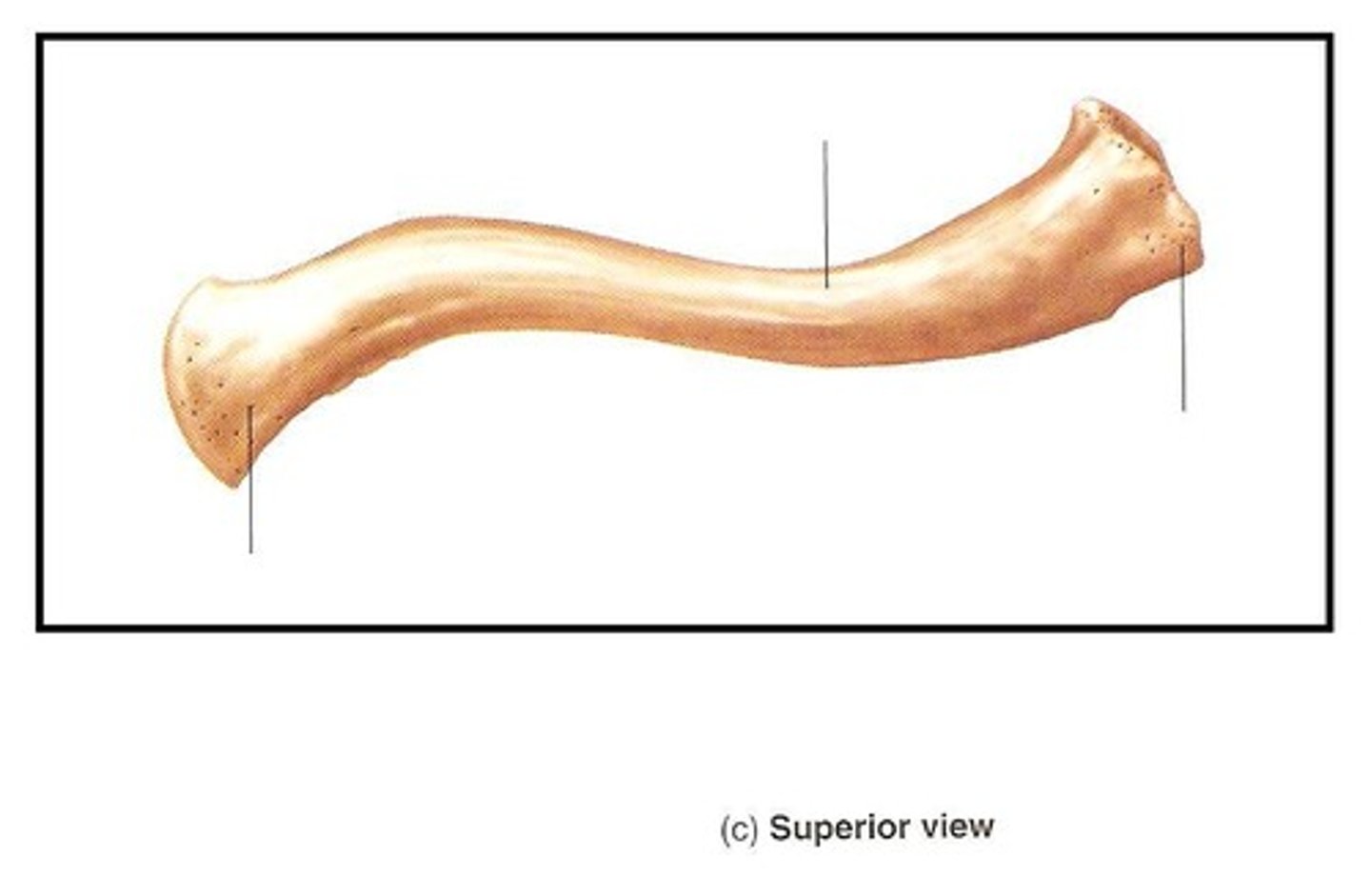
Sternal end of the clavicle
- medial end
- articulates with sternum
- attachment for sternocleidomastoid
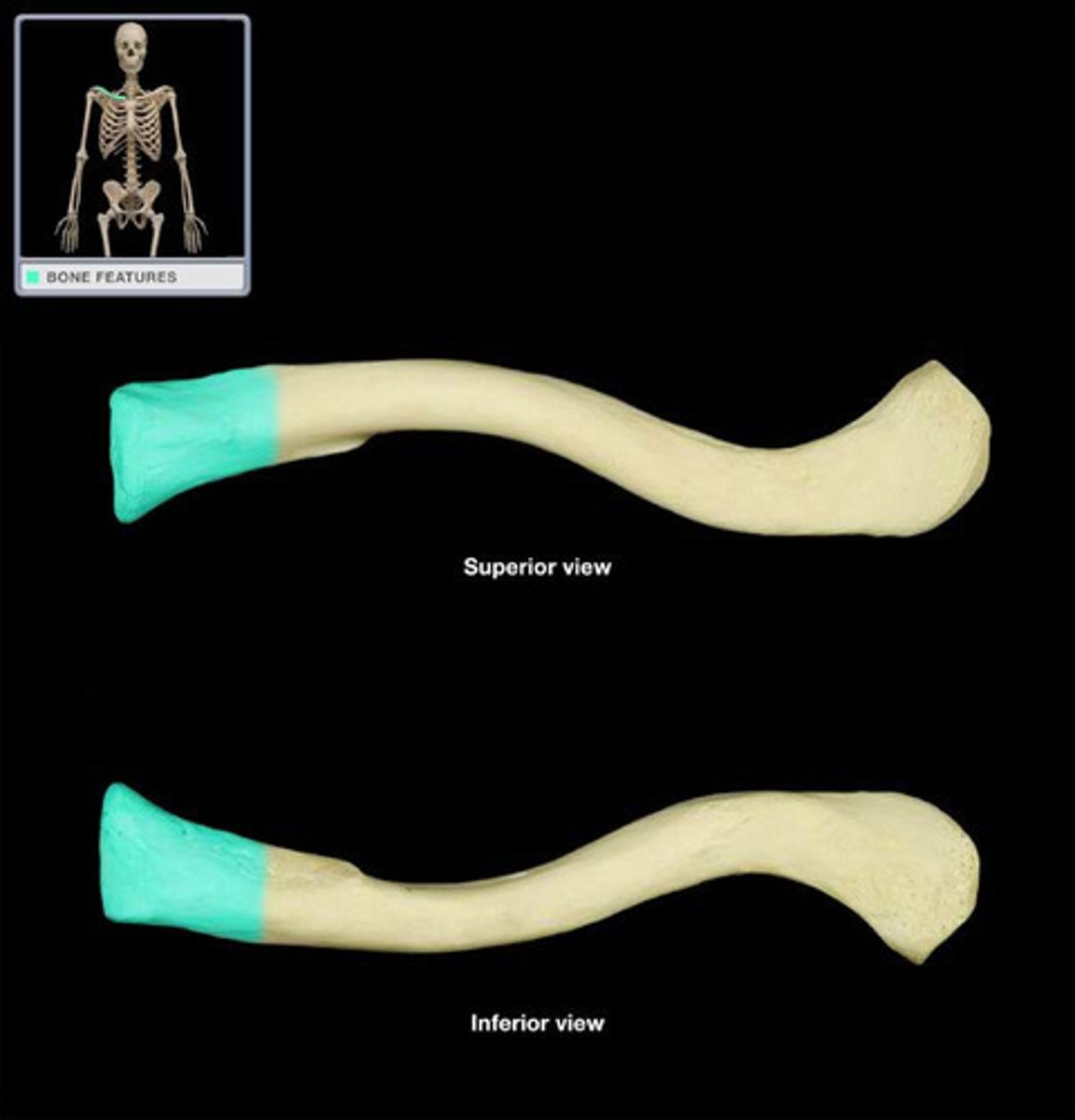
Acromial end of the clavicle
- lateral end
- articulates with acromion process of scapula
- attachment for upper trapezius, pectoralis major (clavicular portion), and anterior deltoid muscles
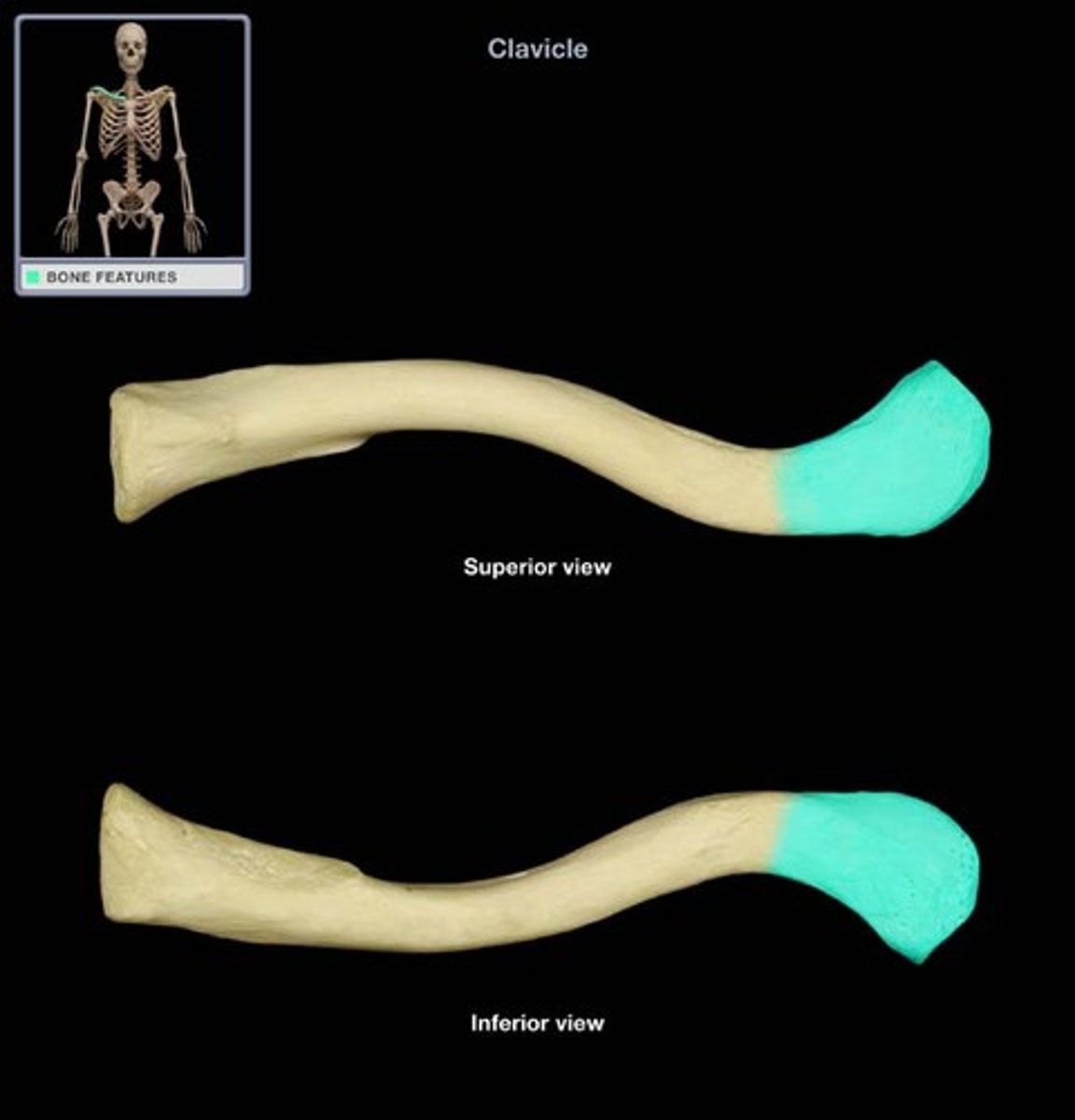
Body of the clavicle
area between sternal and acromial ends
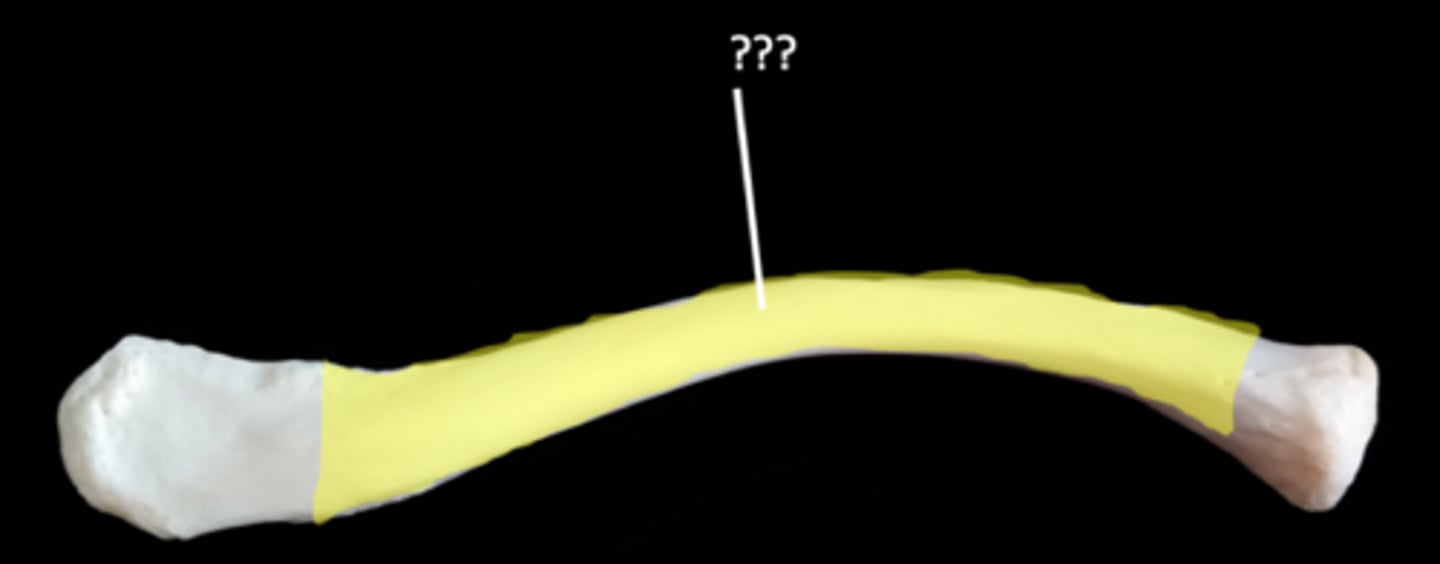
Landmarks of the sternum
manubrium, body, xiphoid process
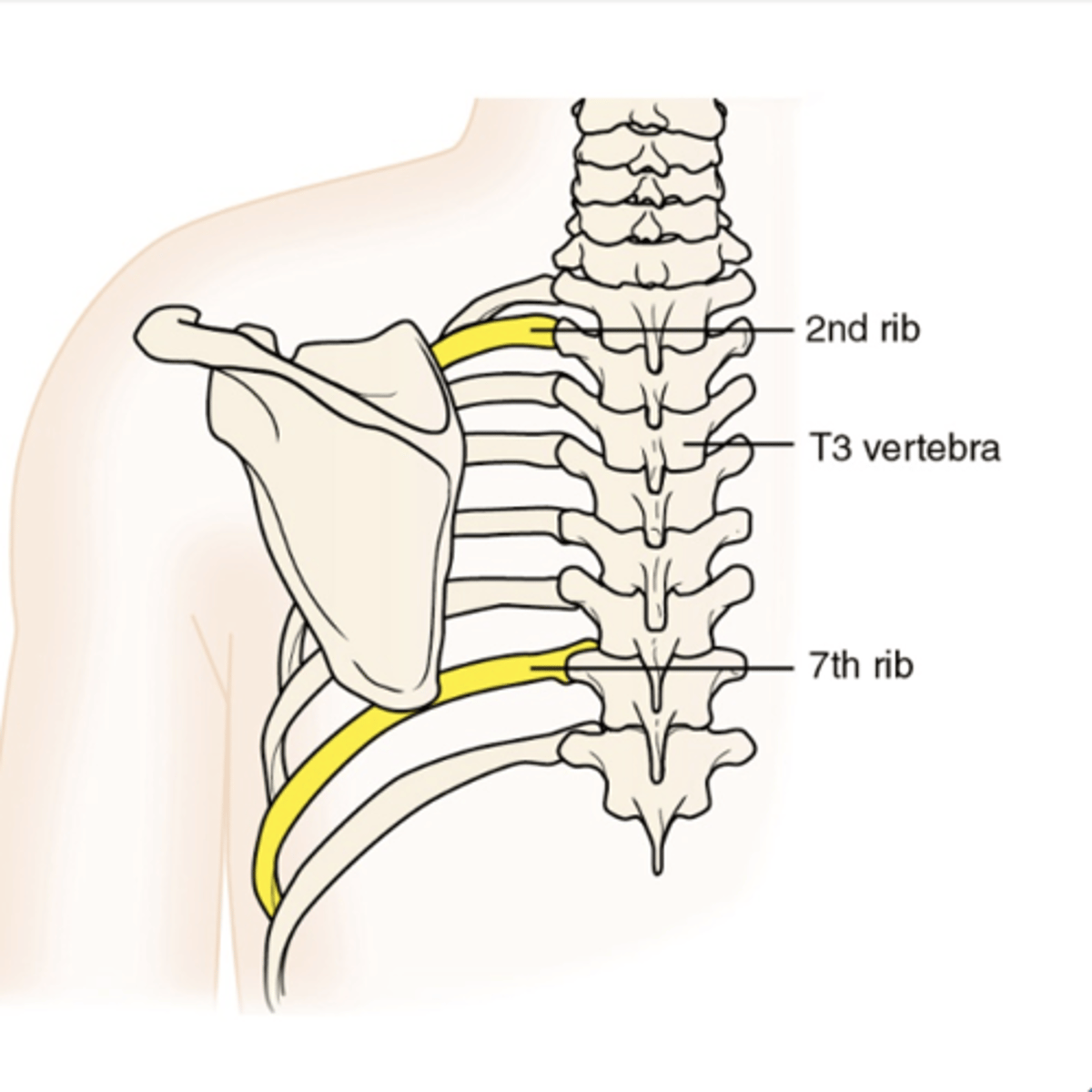
Manubrium of sternum
superior portion of sternum
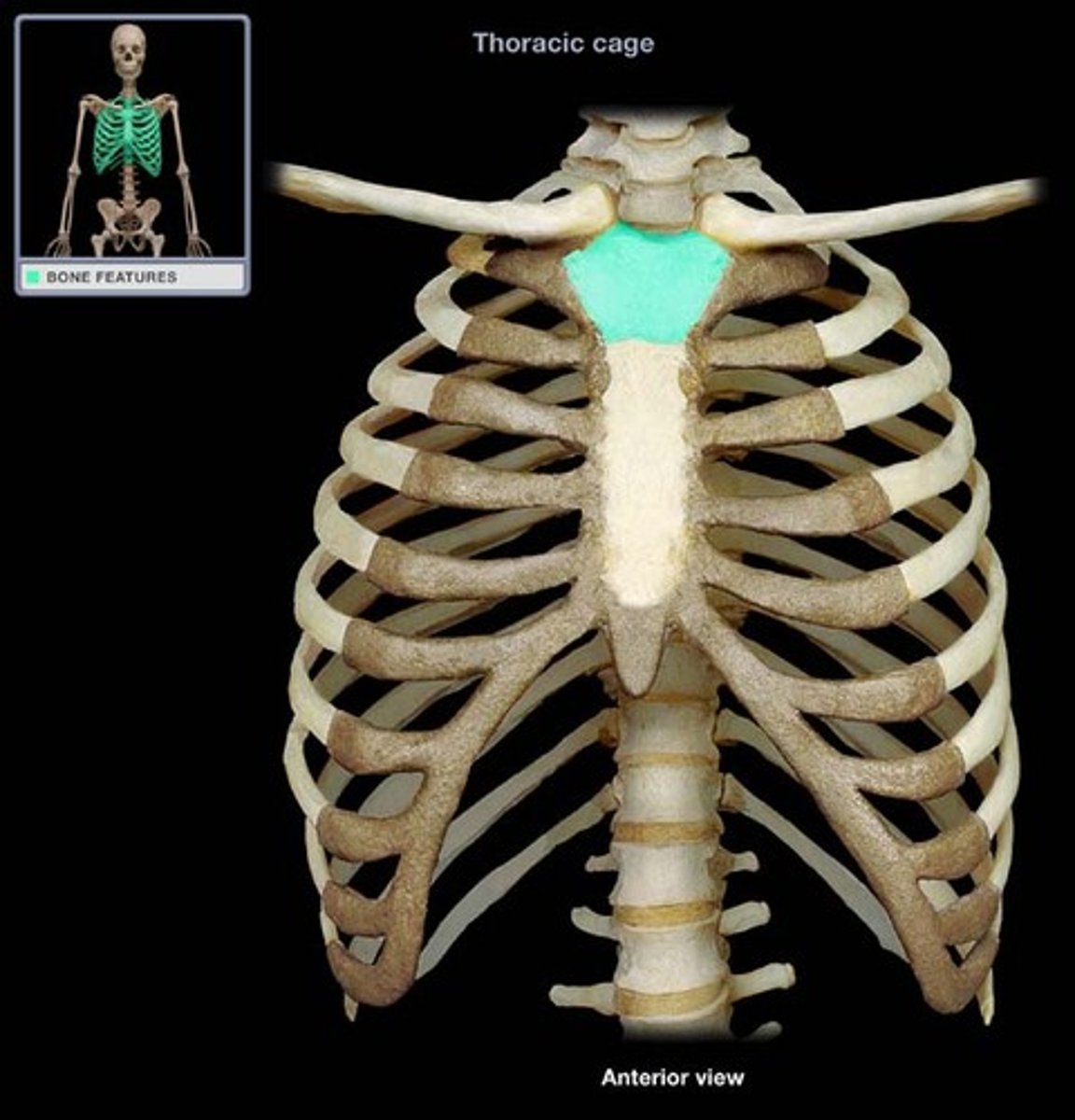
Body of sternum
- middle portion of sternum
- longest portion
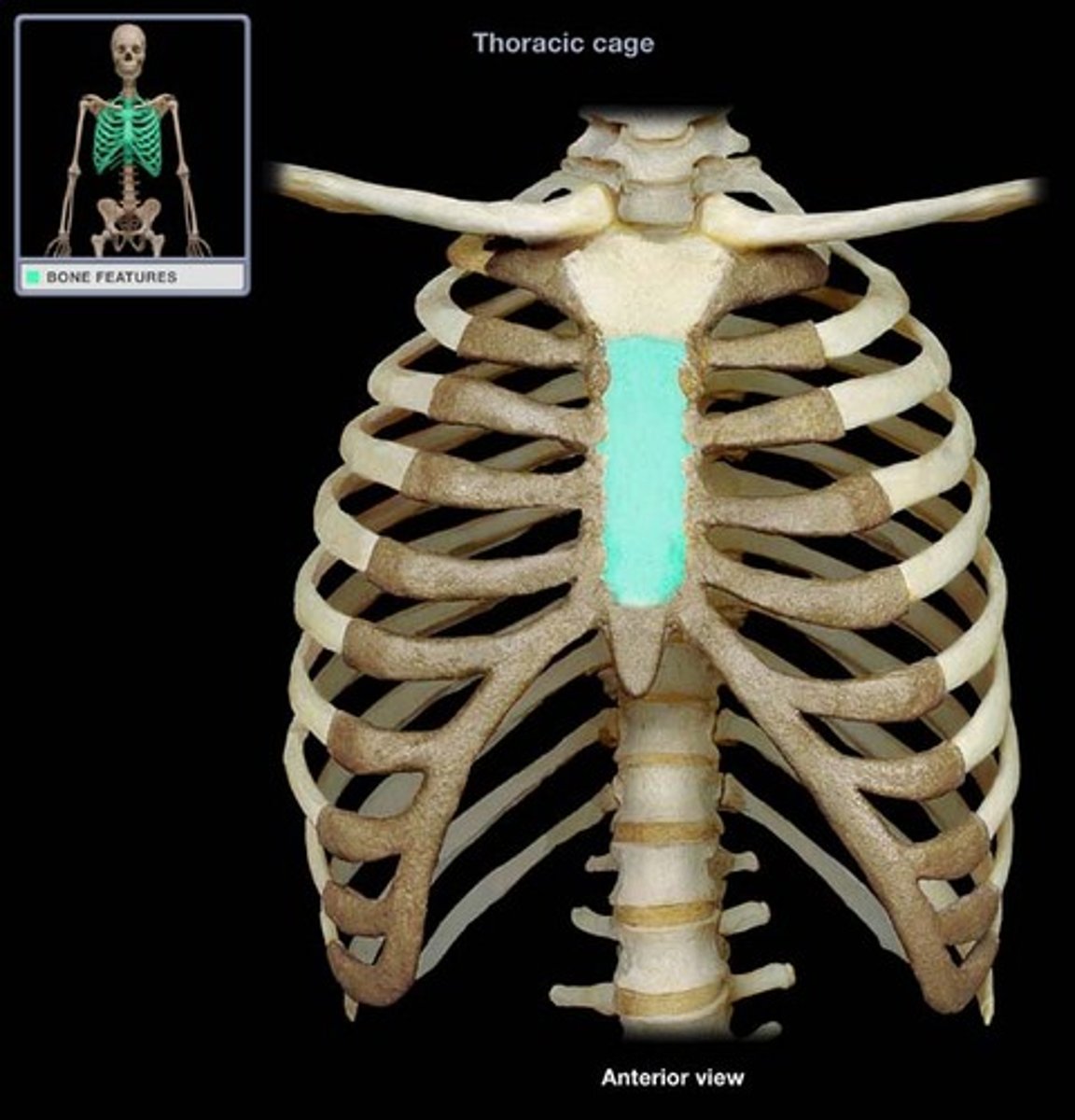
Xiphoid process of sternum
- inferior portion of sternum
- smallest portion
- triangular
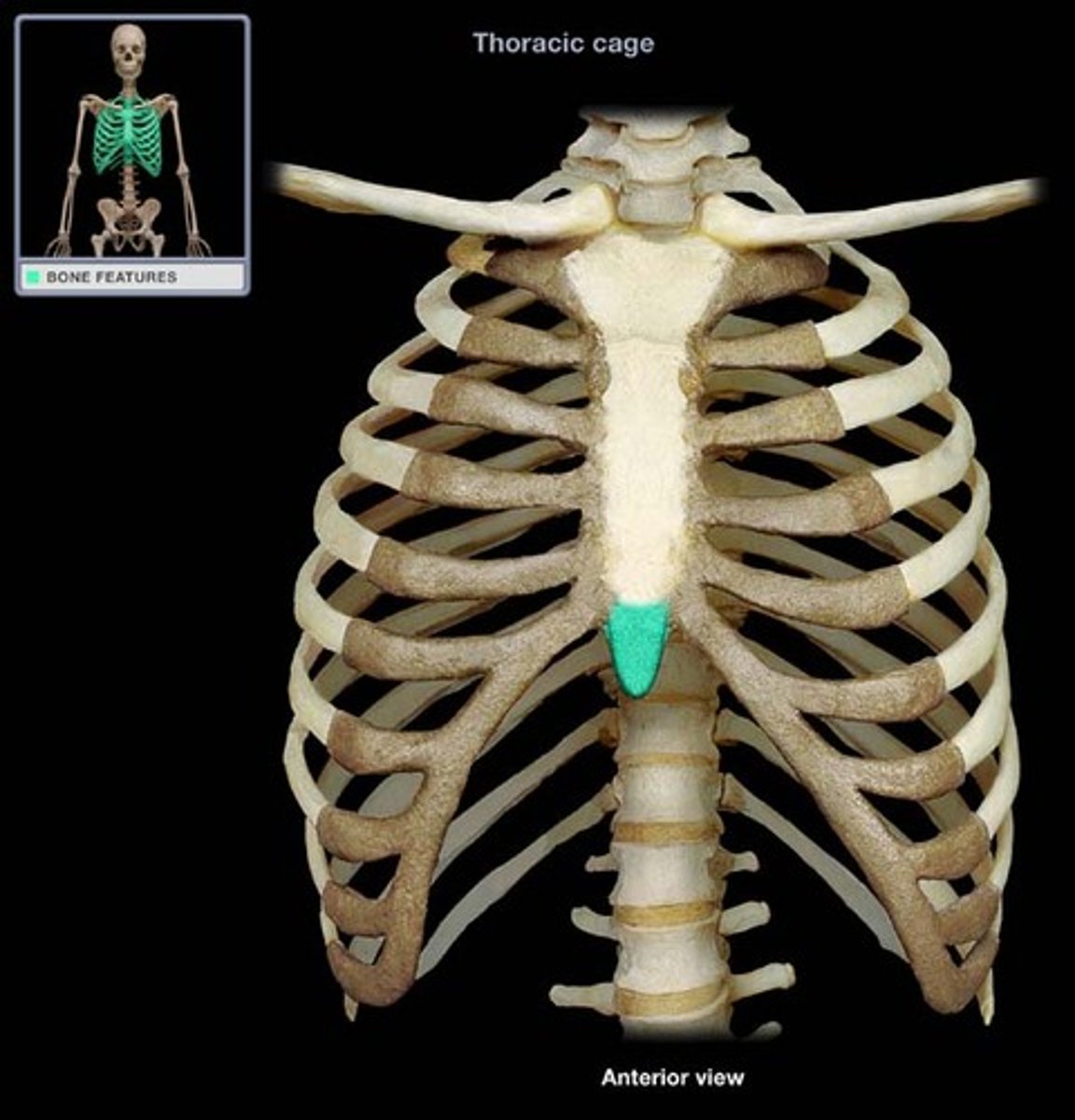
Sternoclavicular joint (SC)
- between manubrium of sternum and medial end of clavicle
- little osteokinematic motion at SC produces significant movement of the scapula due to the length of the lever arm of the clavicle
What type of joint is the Sternoclavicular joint
- synovial
- only attachment of upper extremity to axial skeleton
- functions as a triaxial joint
Joint capsule of the sternoclavicular joint
surrounds the joint and is reinforced by the anterior and posterior sternoclavicular ligaments
Articular disc of the sternoclavicular joint
- shock absorber especially from forces genrated by falls on outstretched arm
- split into two parts
Upper part of articular disc of sternoclavicular joint
attaches to the posterior-superior aspect of the clavicle
Lower part of articular disc of sternoclavicular joint
attaches to the manubrium and first costal cartilage
The sternoclavicular joint as a convex/concave
arthrokinematic motions of roll and glide
Close-Pack of the SC Joint
- full
- abduction, external rotation
Loose-Pack of the SC joint
- 30-60 degrees horizontal abduction
- 30-60 degrees flexion
End feel of SC joint
firm
Capsular pattern of SC joint
ER>Abd>IR
Elevation/depression of the SC joint
in frontal plane about sagittal axis
Protraction/retraction of the SC joint
in the horizontal plane about a vertical axis
Rotation of the SC joint
is a sagittal plane about a frontal axis
SC joint
- only the clavicle moves as part of the SC
- movement of the sternum does not move the SC joint
Ligaments of the sternoclavicular joint
anterior and posterior sternoclavicular ligaments, interclavicular ligament, costoclavicular ligament
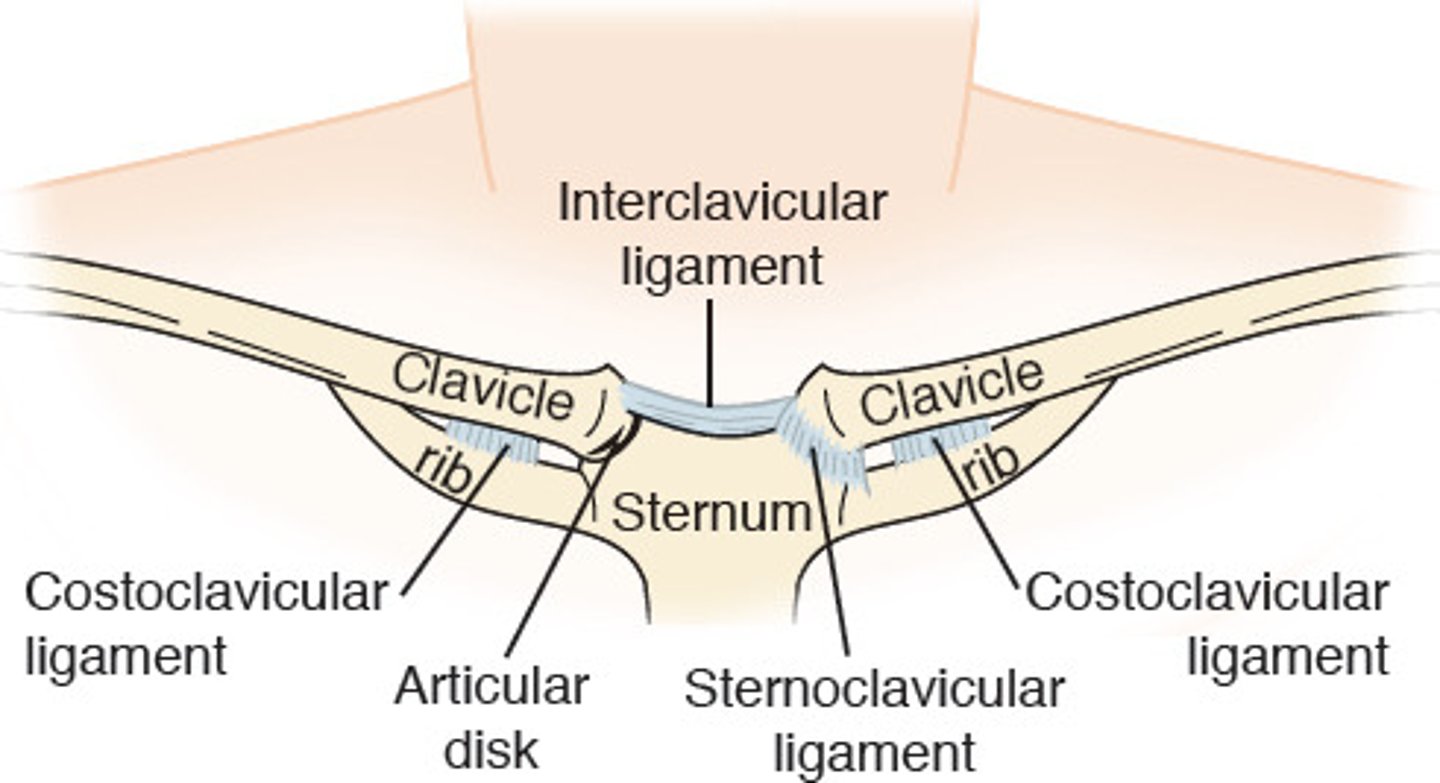
Sternoclavicular ligament
- connects clavicle to manubrium of sternum
- divided into two ligaments
- reinforces joint capsule
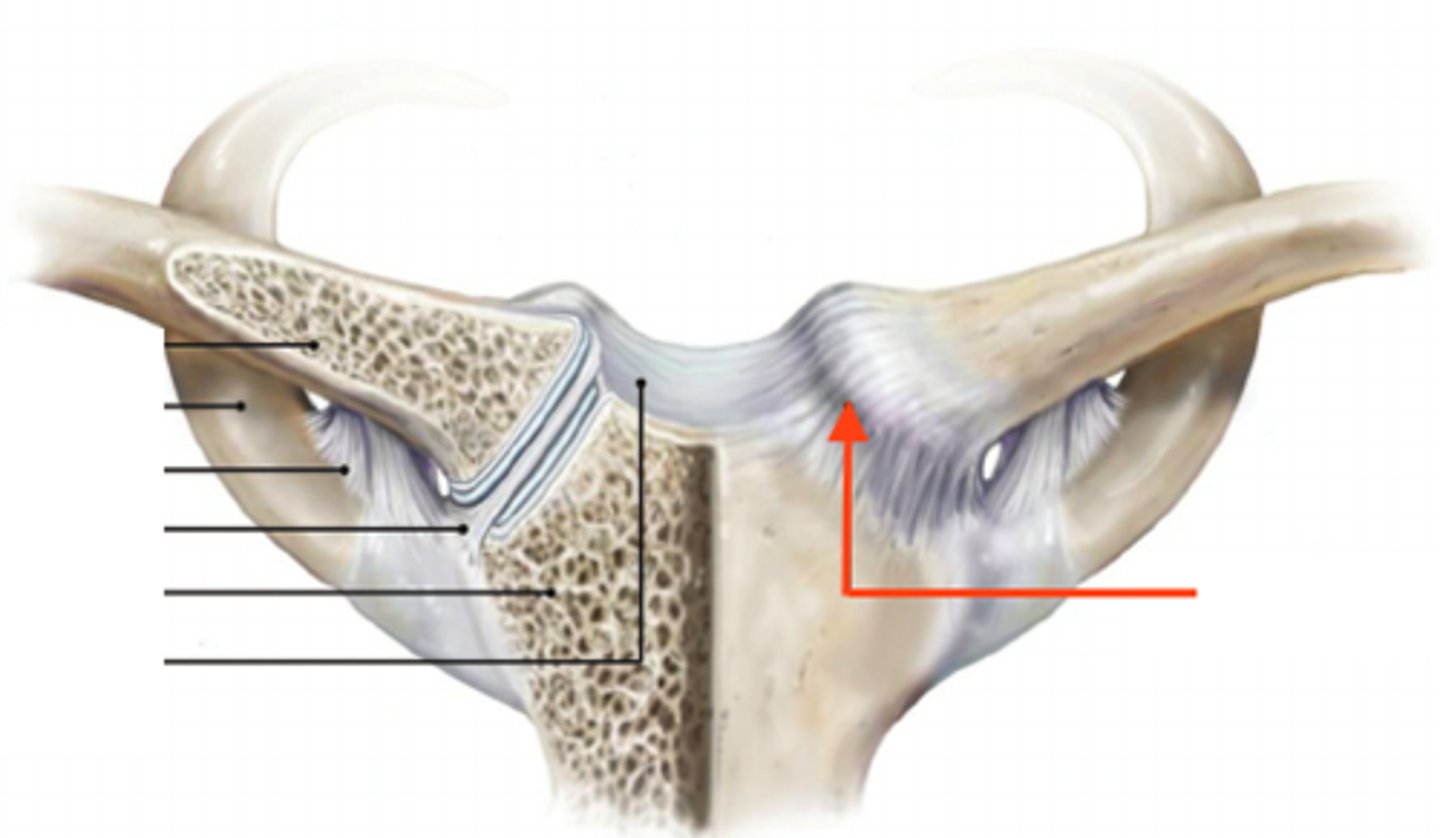
Posterior sternoclavicular ligament
- posterior portion of SC ligament
- connects posterior aspect of manubrium of sternum to posterior aspect of clavicle
- limits posterior movement of medial end of clavicle on sternum (manubrium) during scapular protraction
- limits anterior motion of clavicle during scapular retraction
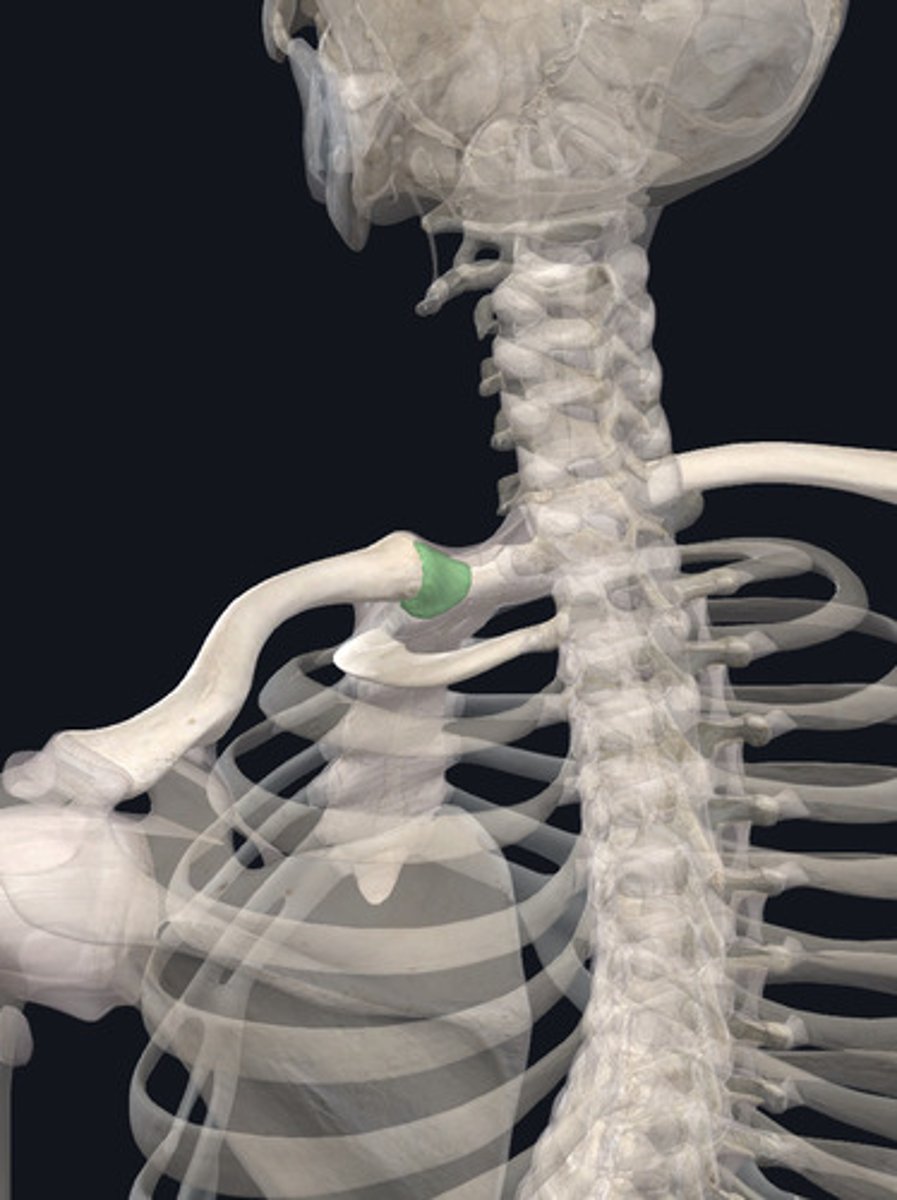
Anterior sternoclavicular ligament
- anterior portion of SC ligament
- connects anterior aspect of manubrium of sternum to anterior aspect of clavicle
- limits anterior movement of medial end of clavicle on sternum (manubrium) during scapular retraction
- limits posterior motion of the clavicle during scapular protraction
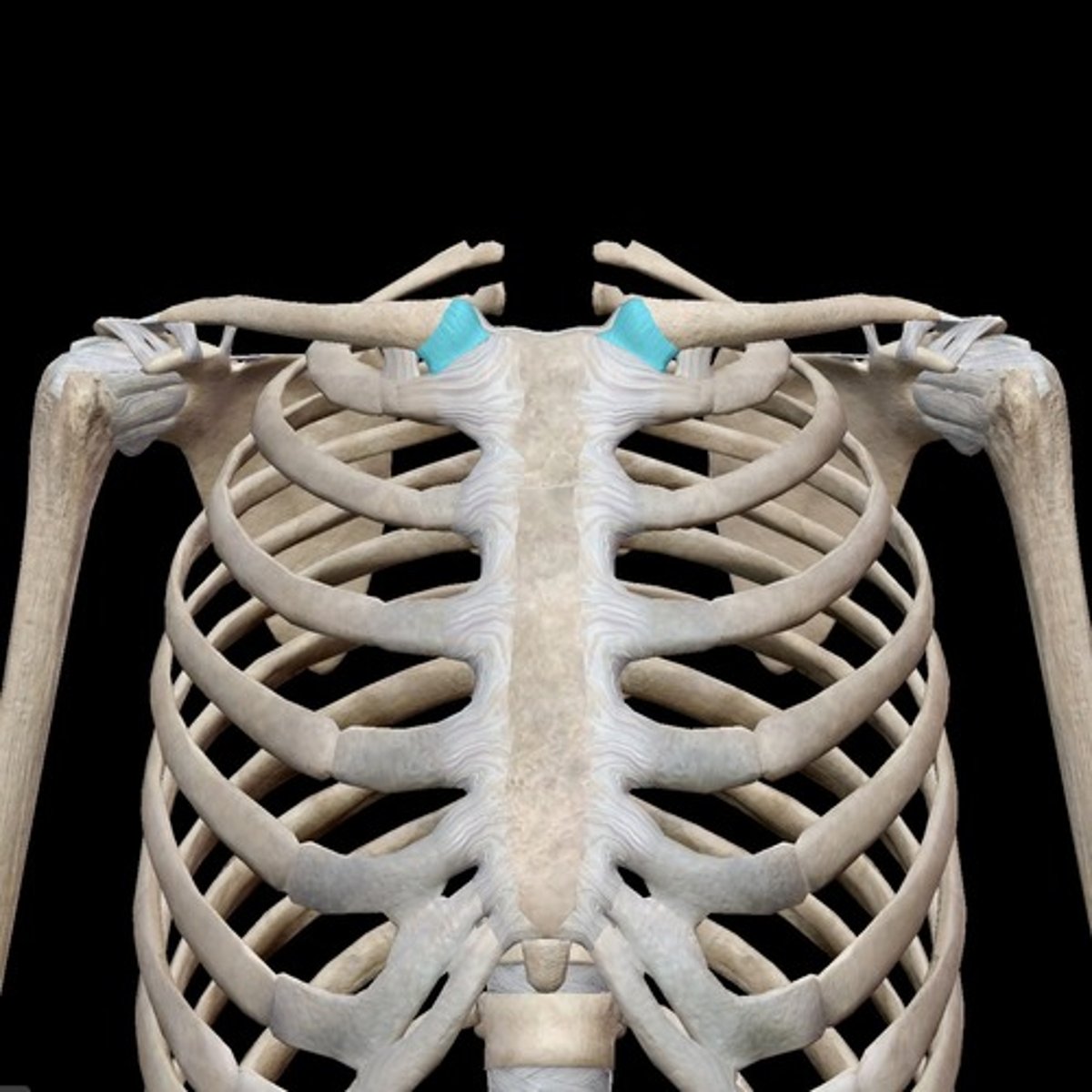
Costoclavicular ligament
- short, flat, rhomboid-shaped
- connects inferior surface of medial end of clavicle to superior surface of costal cartilage of first rib
- limits clavicular elevation
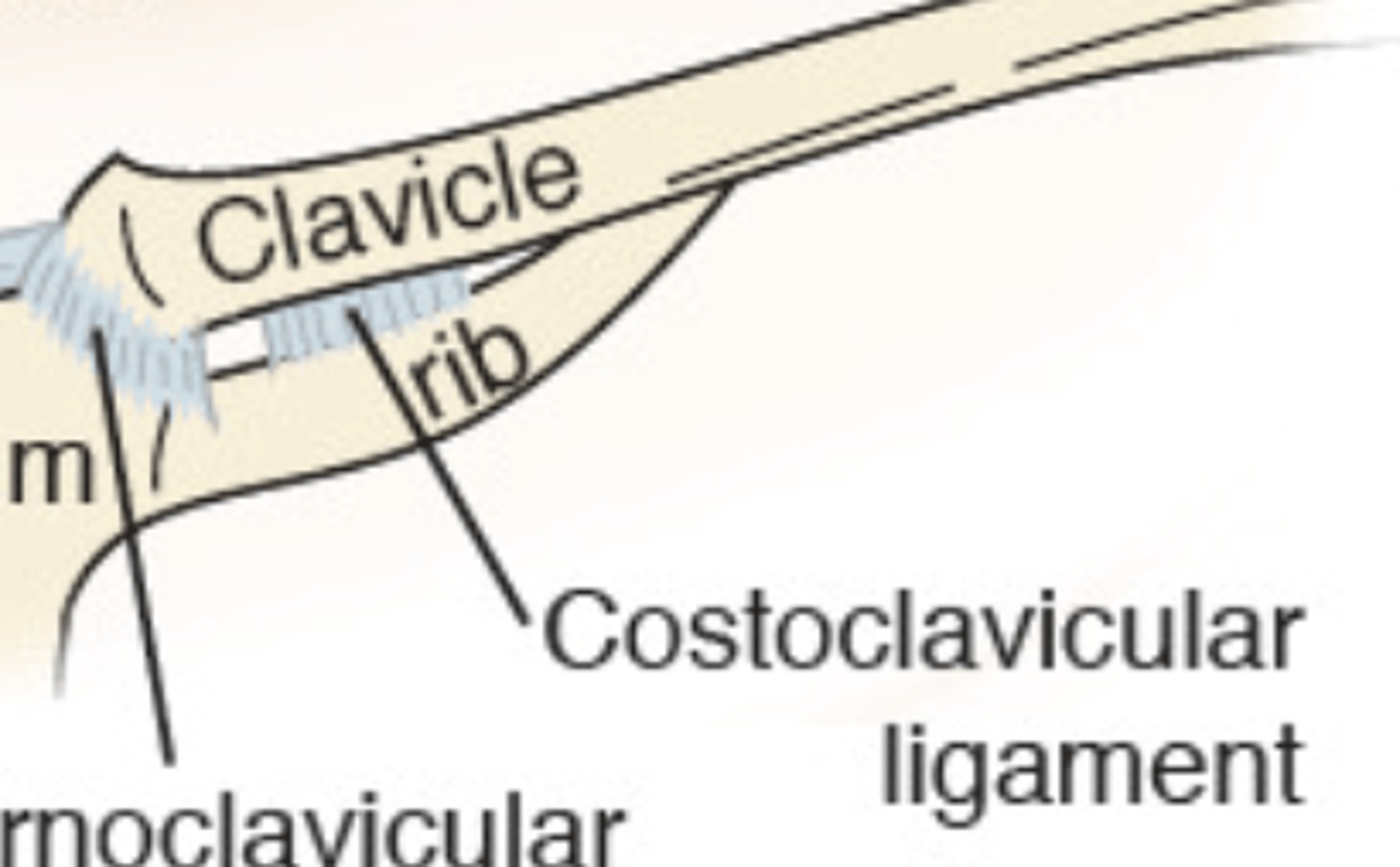
Interclavicular ligament
- located superiorly on manubrium
- connects superior and medial ends of clavicles
- limits clavicular depression
Acromioclavicular joint (AC)
- articulation of the acromion process of the scapula and the lateral (acromial) end of the clavicle
- synovial joint
- plane joint minimal motion
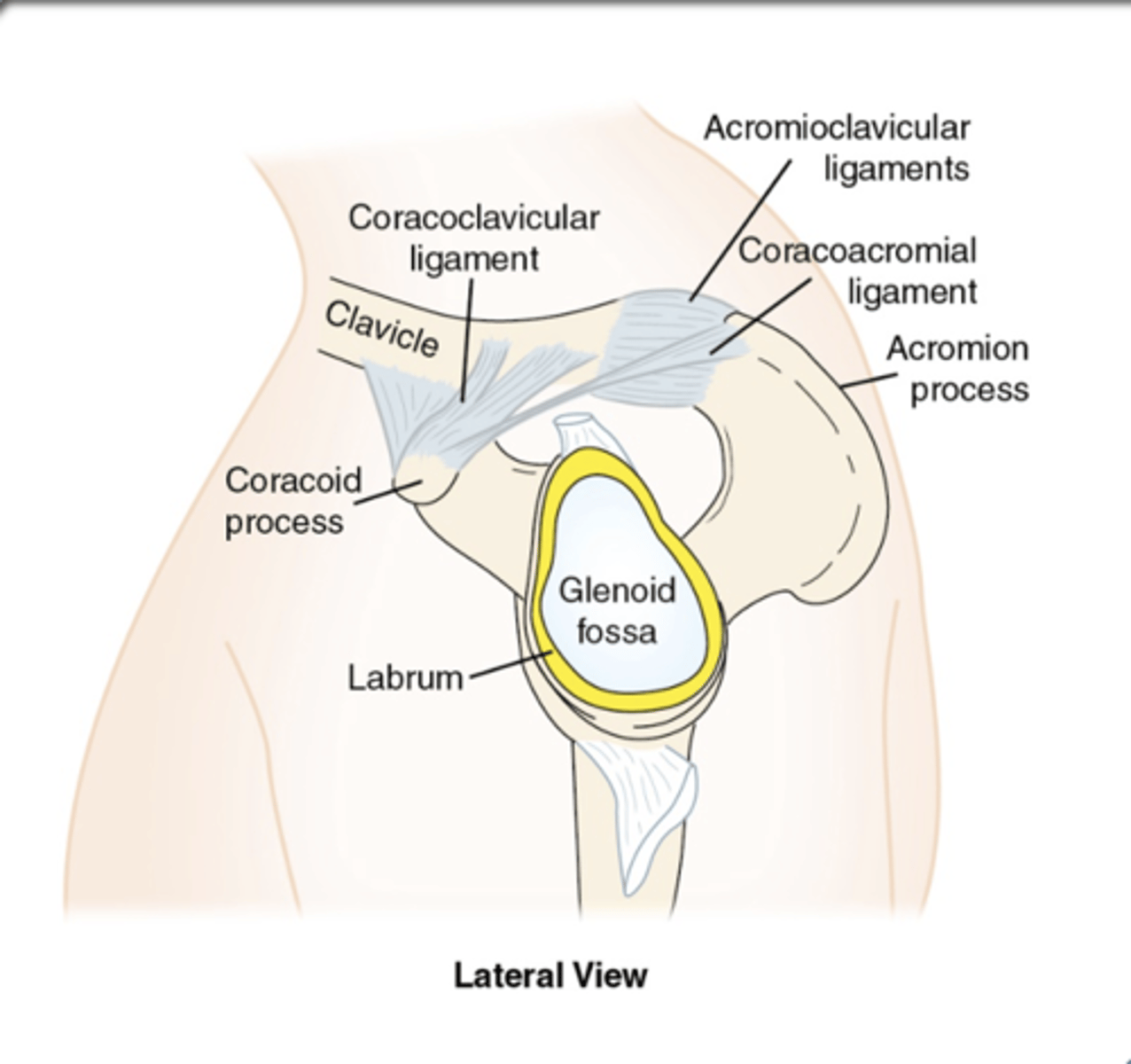
Ligaments of the acromioclavicular joint
acromioclavicular ligament (superior and inferior), coracoclavicular ligament, coracoacromial ligamnet
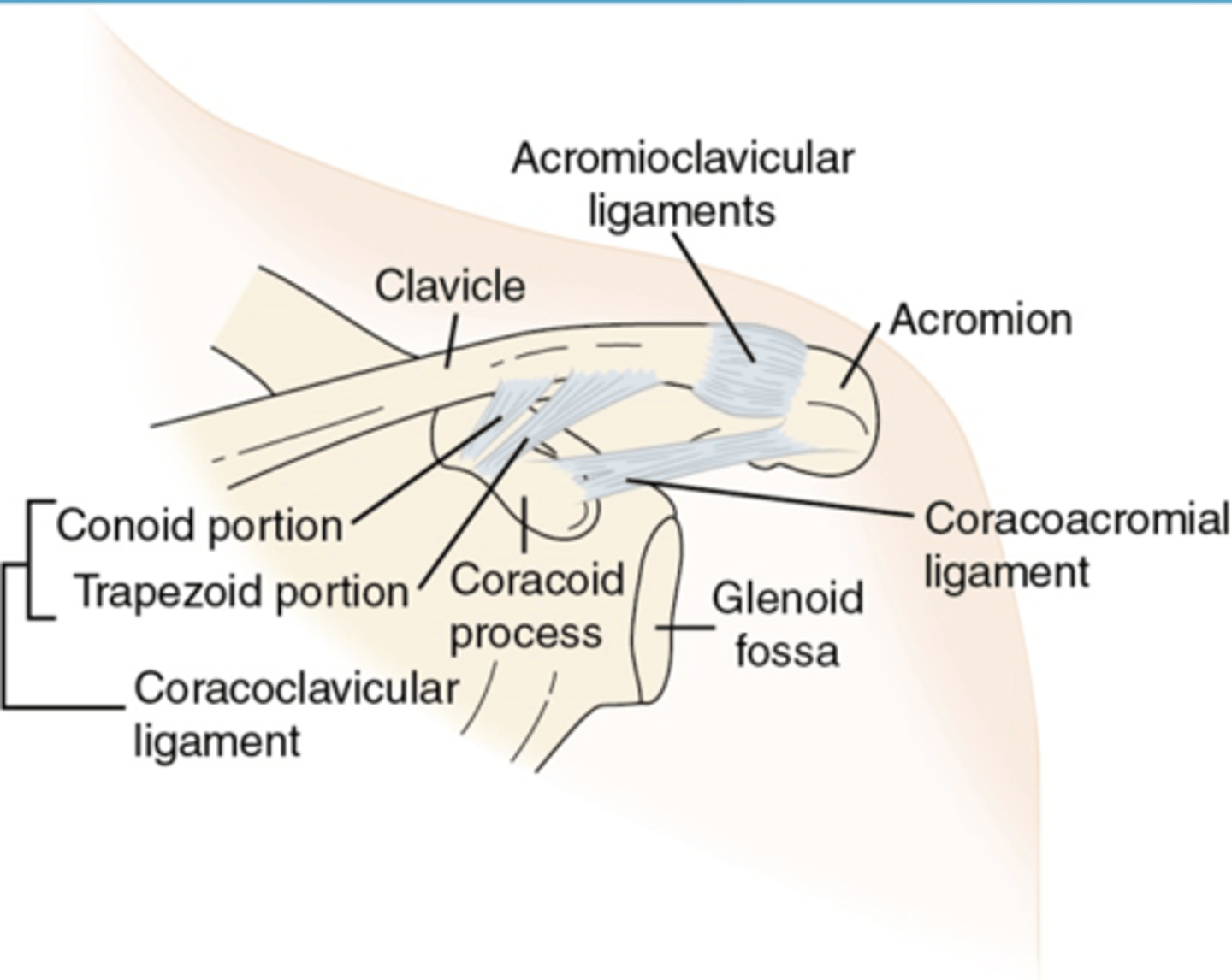
Acromioclavicular ligament
- divided into two ligaments
- connects lateral end of clavicle to acromion of scapula
- reinforces joint capsule
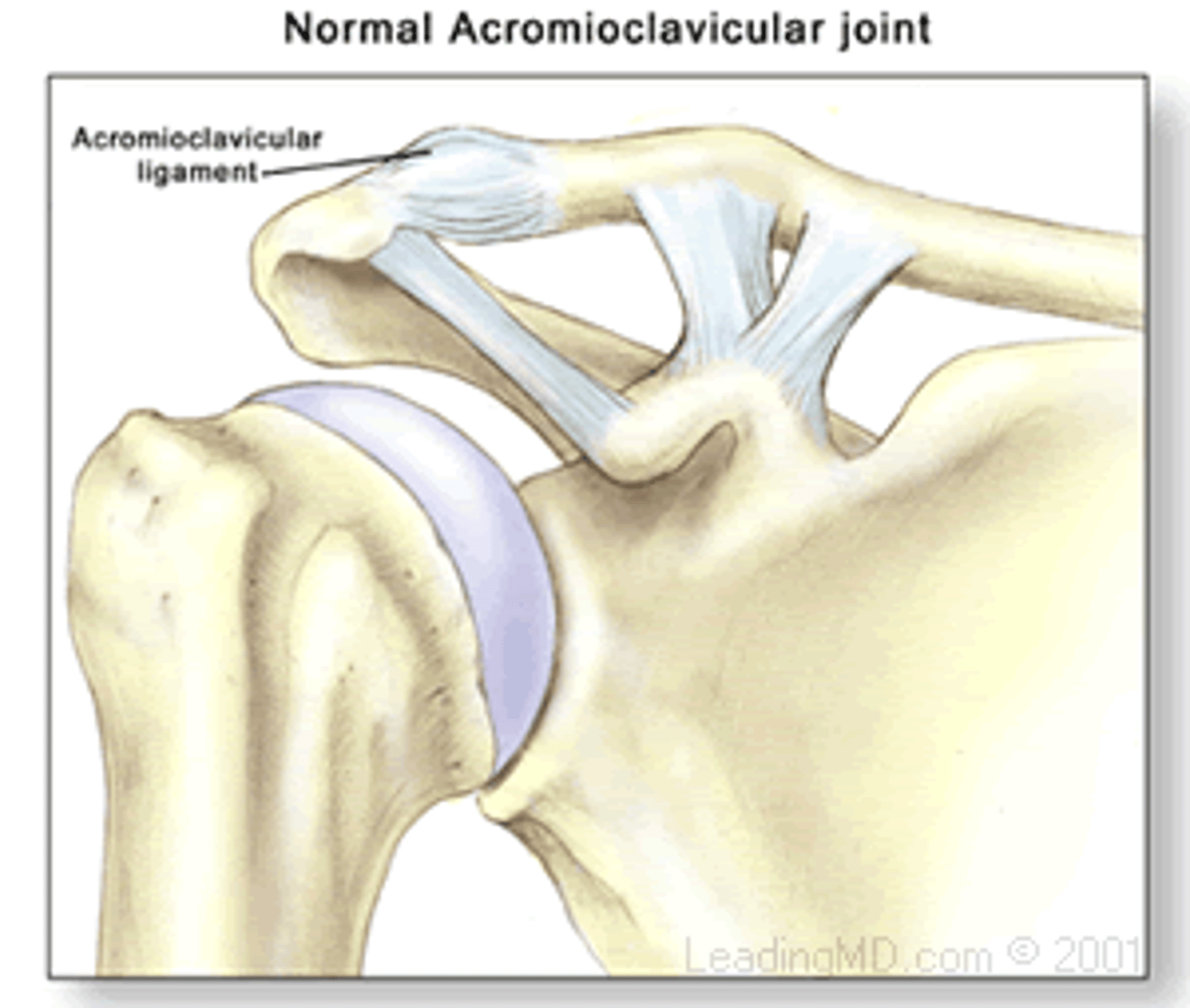
Superior acromioclavicular ligament
- superior portion of AC ligament
- connects superior aspect of clavicle to superior aspect of acromion
- reinforces superior portion of capsule
Inferior acromioclavicular ligament
- inferior portion of AC ligament
- connects inferior aspect of clavicle to inferior aspect of acromion
- reinforces inferior portion of capsule
Coracoclavicular ligament
- two portions: lateral trapezoid and medial concoid
- connects superior surface of coracoid process of scapula to inferior lateral end of clavicle
- limits posterior movement of clavicle and rotation of scapula
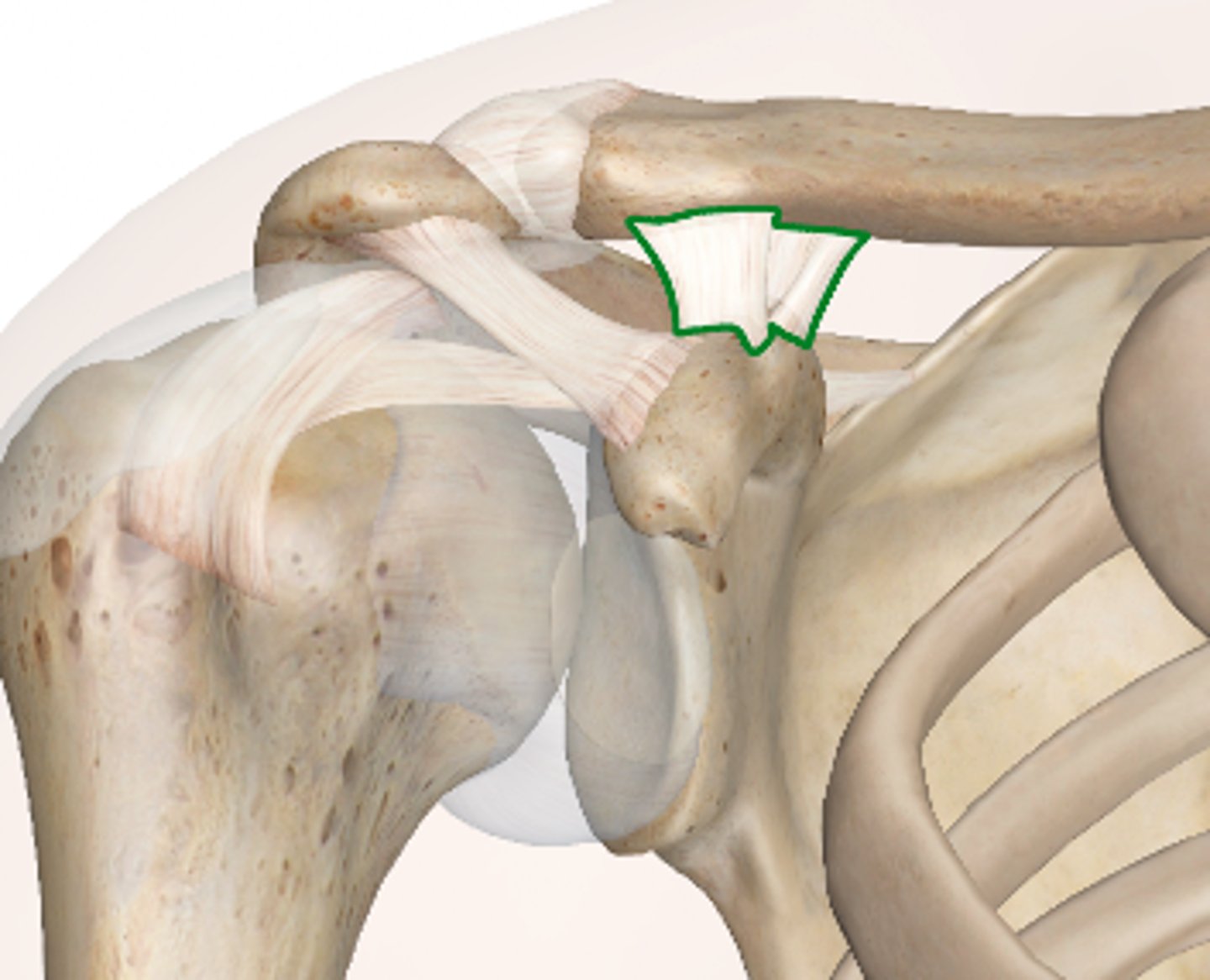
Coracoacromial ligament
- forms roof over head of humerus
- connects lateral superior surface of coracoid process and inferior surface of acromion
- protects head of humerus
- limits superior movement of humeral head when upward force is transmitted along humerus
Trapezius muscles
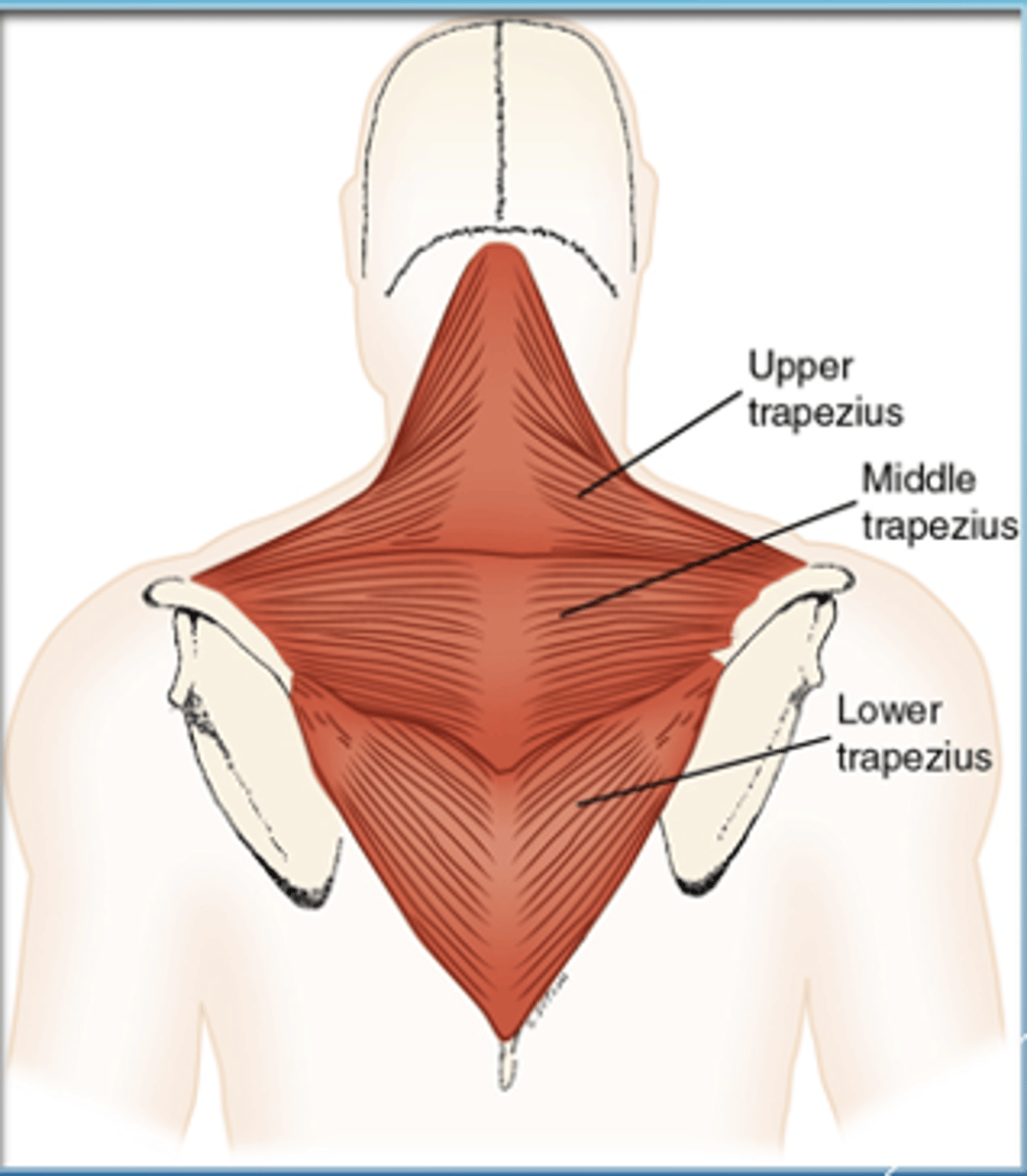
Upper trapezius
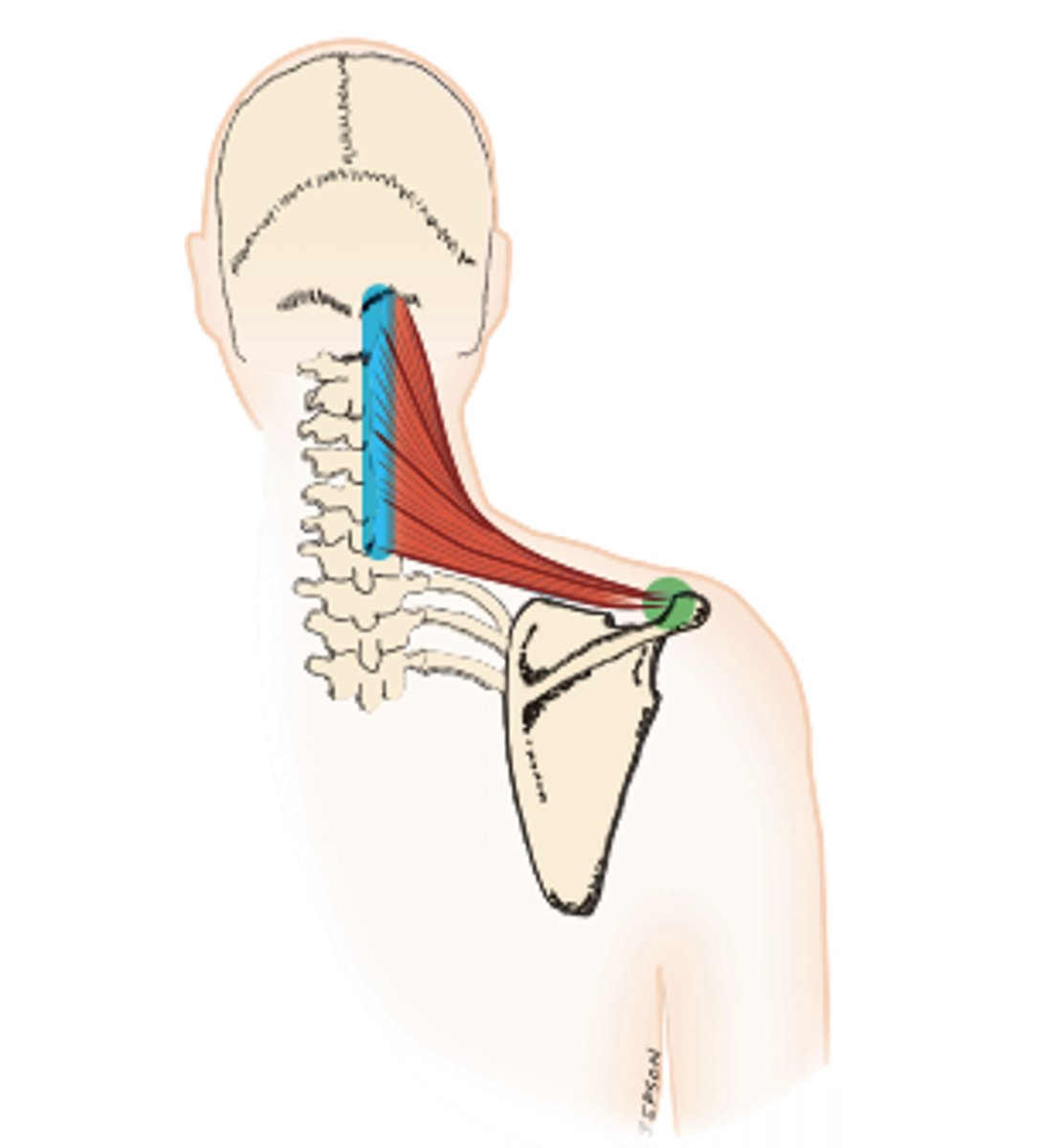
Upper trapezius (O)
external occipital protuberance, superior nuchal line, spinous processes of cervical vertebrae via nuchal ligament
Upper trapezius (I)
lateral third of clavicle, acromion process
Upper trapezius (A)
- scapular elevation, upward rotation, retraction
- capital and cervical extension and lateral flexion when scapula is stabilized
Upper trapezius (N)
spinal accessory (cranial nerve XI), C3 and C4 sensory component
Middle trapezius
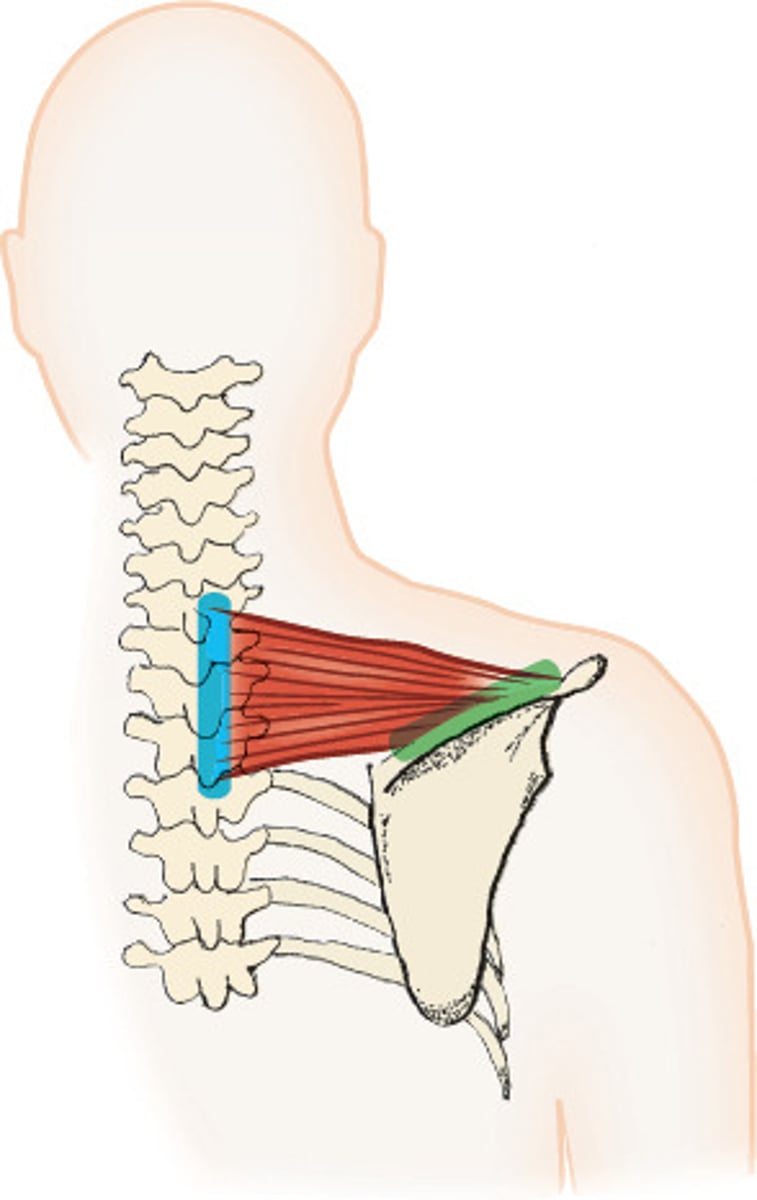
Middle trapezius (O)
spinous processes of C7 through T3 via supraspinal ligament
Middle trapezius (I)
medial aspect of acromion and spine of scapula
Middle trapezius (A)
scapular retraction, upward rotation (minimal)
Middle trapezius (N)
spinal accessory (cranial nerve XI), C3 and C4 sensory component
Lower trapezius
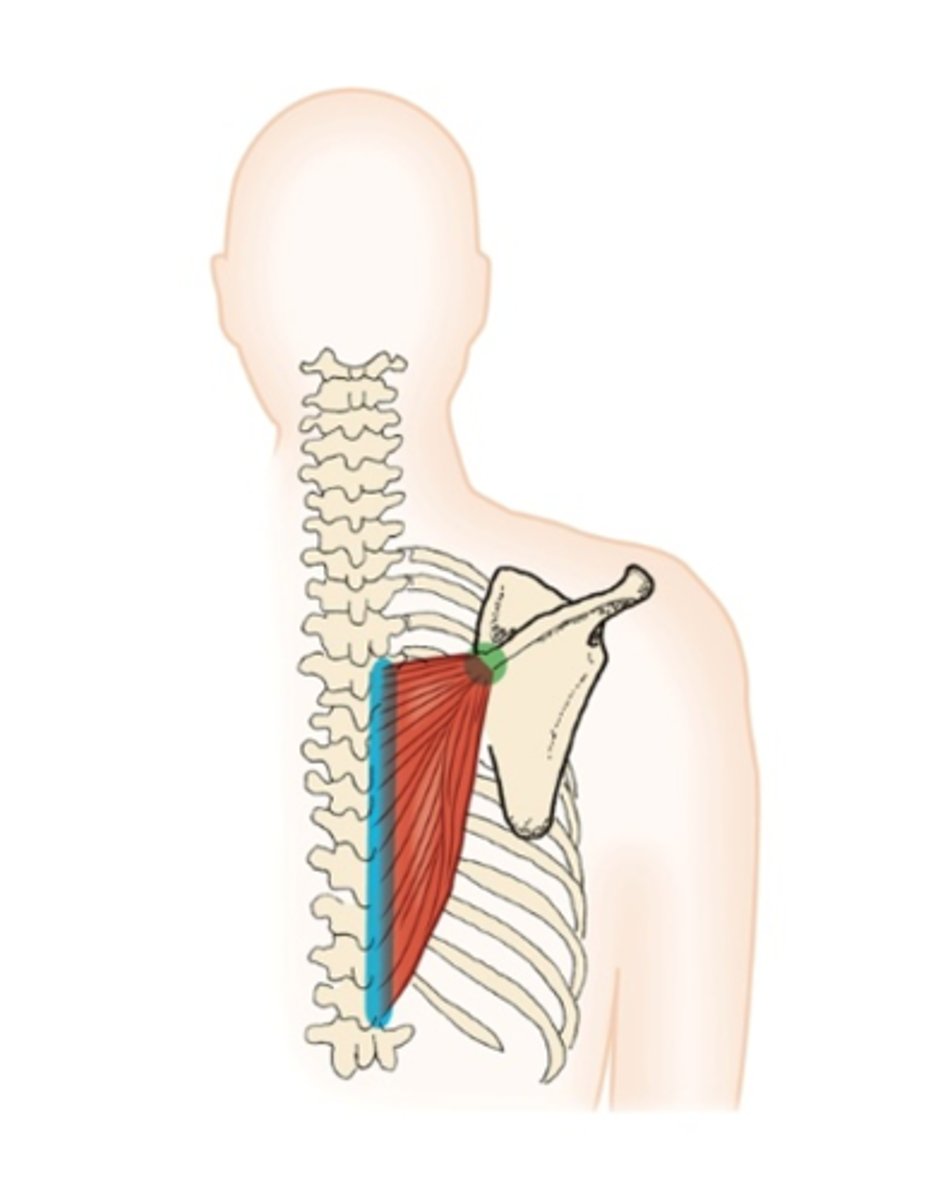
Lower trapezius (O)
spinous processes of T4 through T12 via supraspinal ligament
Lower trapezius (I)
base of spine of the scapula
Lower trapezius (A)
scapular depression, upward rotation, retraction
Lower trapezius (N)
spinal accessory (cranial nerve XI), C3 and C4 sensory component
Levator Scapula muscle
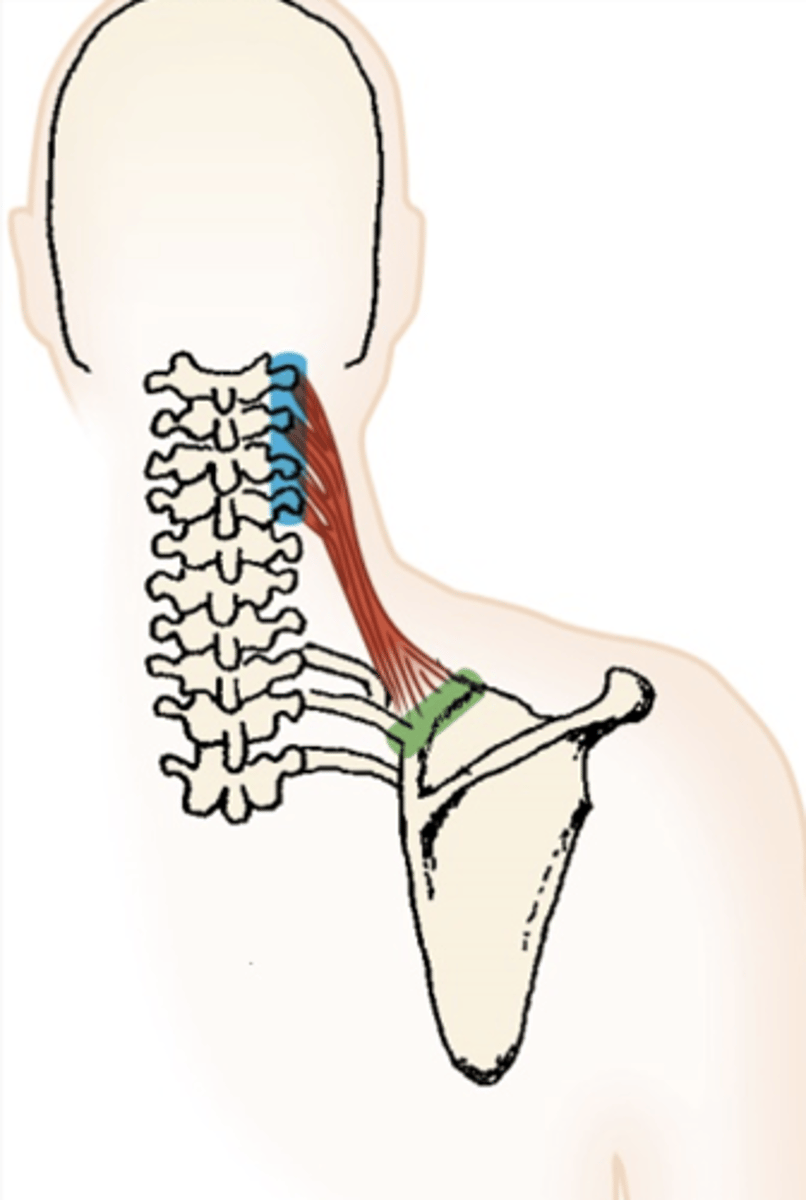
Levator Scapula (O)
transverse process C1 through C4
Levator Scapula (I)
vertebral border of scapula between superior angle and spine of scapula
Levator Scapula (A)
- scapular elevation, downward rotation
- lateral flexion of cervical spine when scapula is stabilized
Levator Scapula (N)
third and fourth cervical nerves and dorsal scapular nerve (C5)
Rhomboid muscles
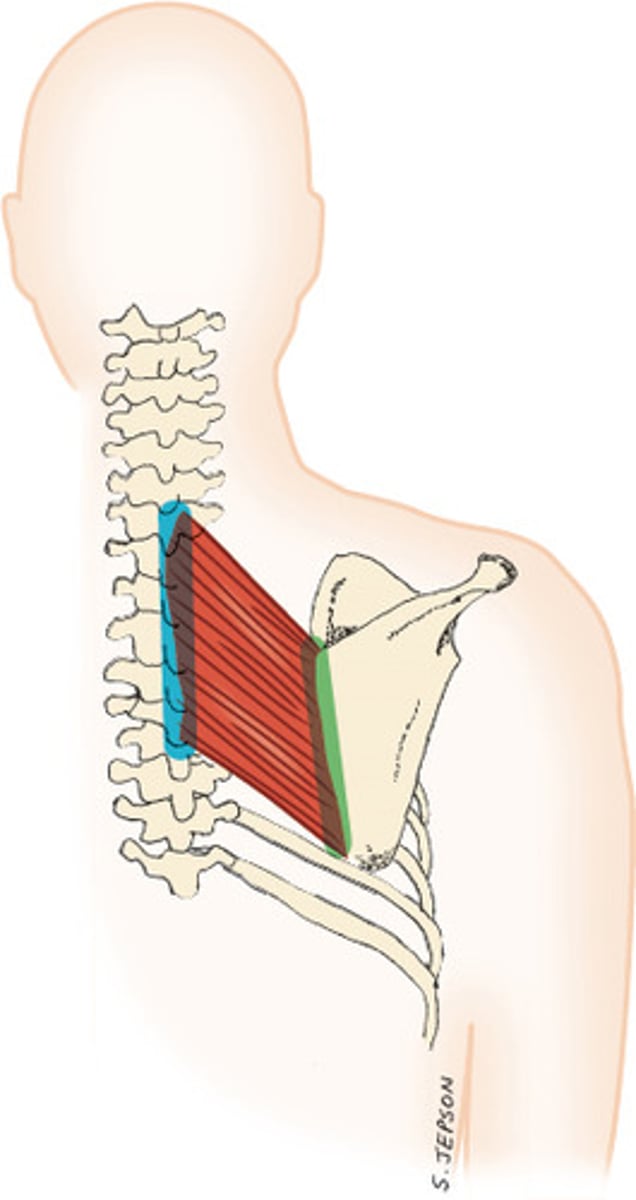
Rhomboid (O)
spinous process of C7 through T5 via nuchal and supraspinal ligaments
Rhomboid (I)
vertebral border of scapula between inferior angle and base of spine of scapula
Rhomboid (A)
scapular retraction, elevation, downward rotation
Rhomboid (N)
dorsal scapular nerve (C5)
Serratus Anterior Muscle
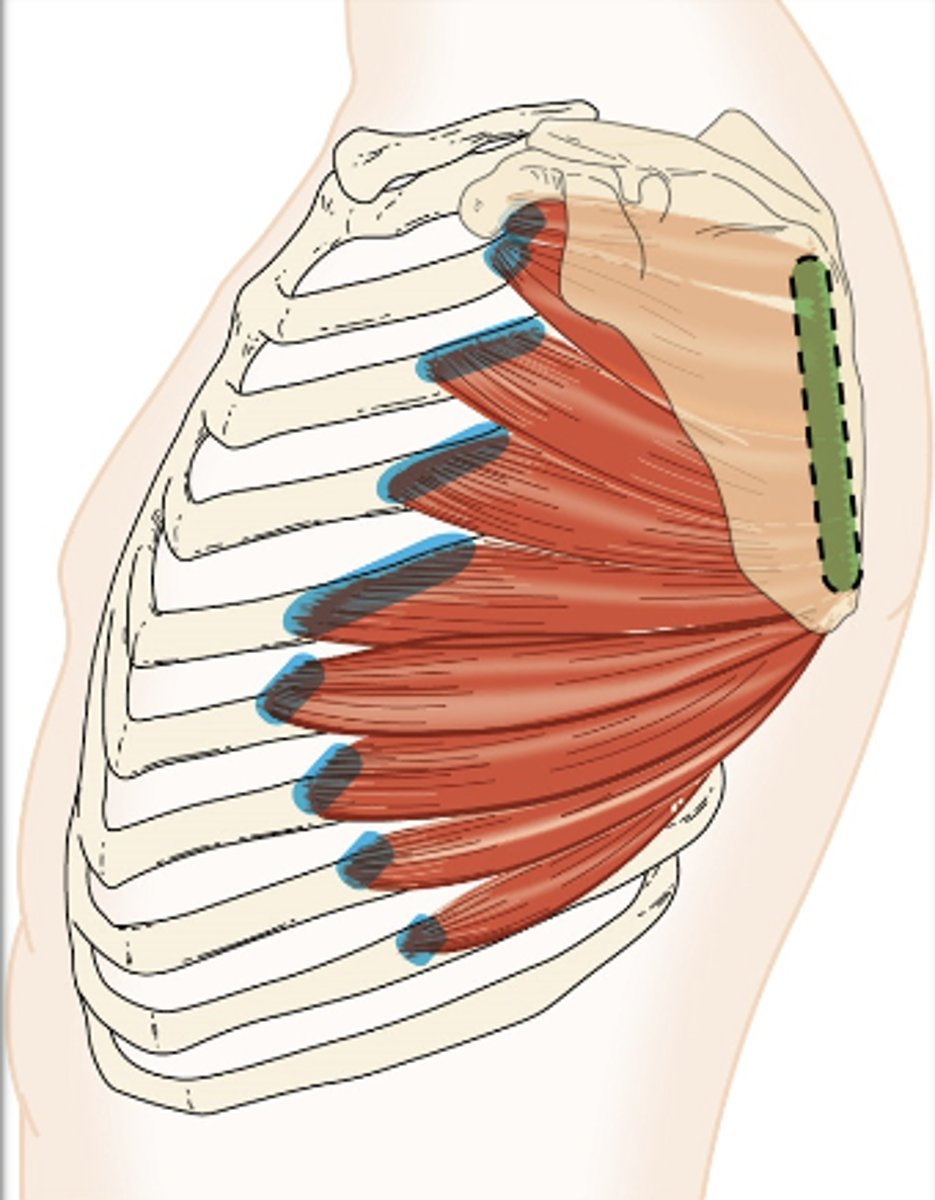
Serratus Anterior (O)
lateral surface of first (1st) through eighth (8th) ribs
Serratus Anterior (I)
vertebral border of scapula, anterior surface
Serratus Anterior (A)
- scapular protraction and upward rotation
- elevation of thoracic cage when shoulder girdle is stabilized
- accessory muscle of respiration (inhalation)
Serratus Anterior (N)
long thoracic nerve (C5, C6, C7)
Pectoralis minor muscles
